So far this year, Austin has had a pretty mild winter. As a result I did a lot of walking in late January/early February. These photos were taken on different days, but I've tried to put them in order by location. This thread covers S. Lamar from Ben White into downtown, Congress Avenue from Cesar Chavez to the State Capitol, and some views from the State Capitol. All photos are from 2009 unless otherwise noted in bold.
01. Freebirds World Burritos in Brodie Oaks Shopping Center on S. Lamar Blvd. near Ben White. Nothing says "Keep Austin Weird" like a hippie bus.
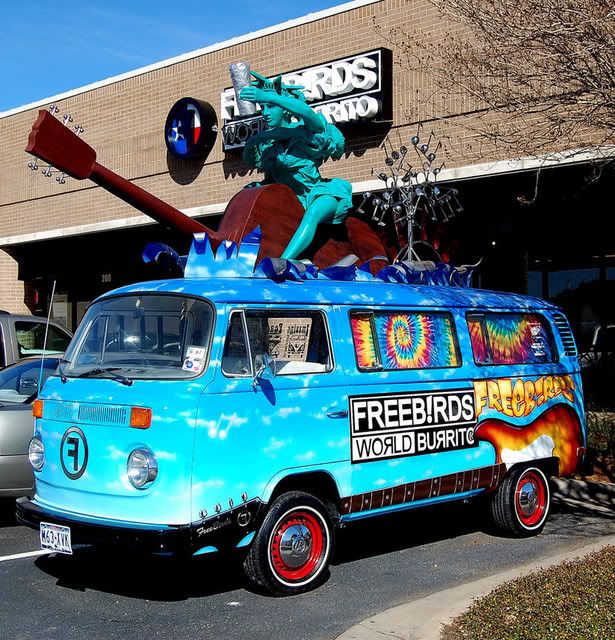
02. More fine dining in my 'hood. Hot Dog stand on S. Lamar.
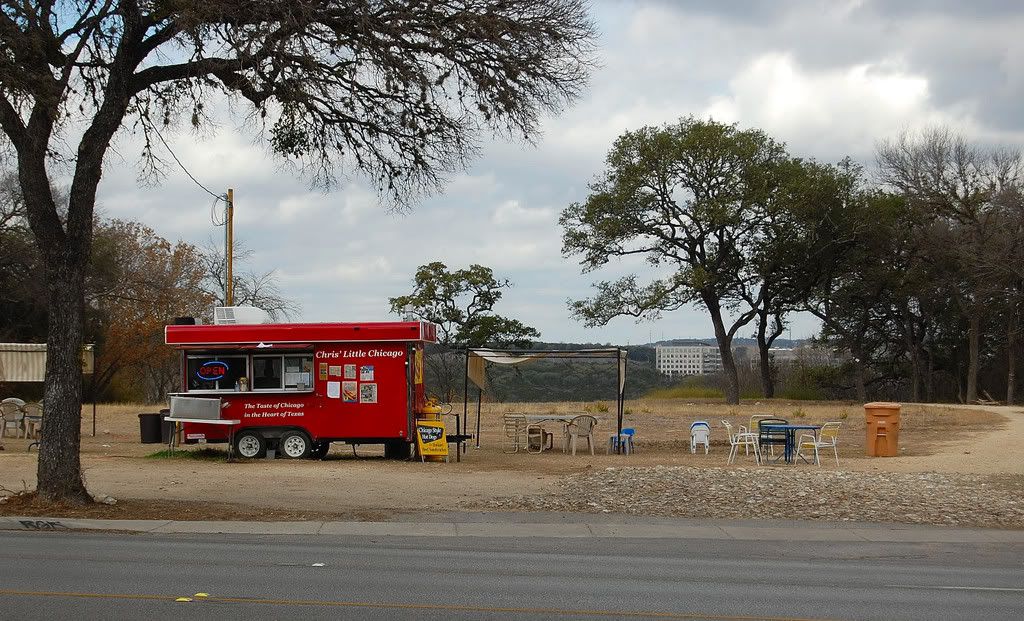
The above property was slated to become a four-story 69-unit condominium called The View, but was cancelled.
03. South Lamar Blvd with downtown skyline in the distance
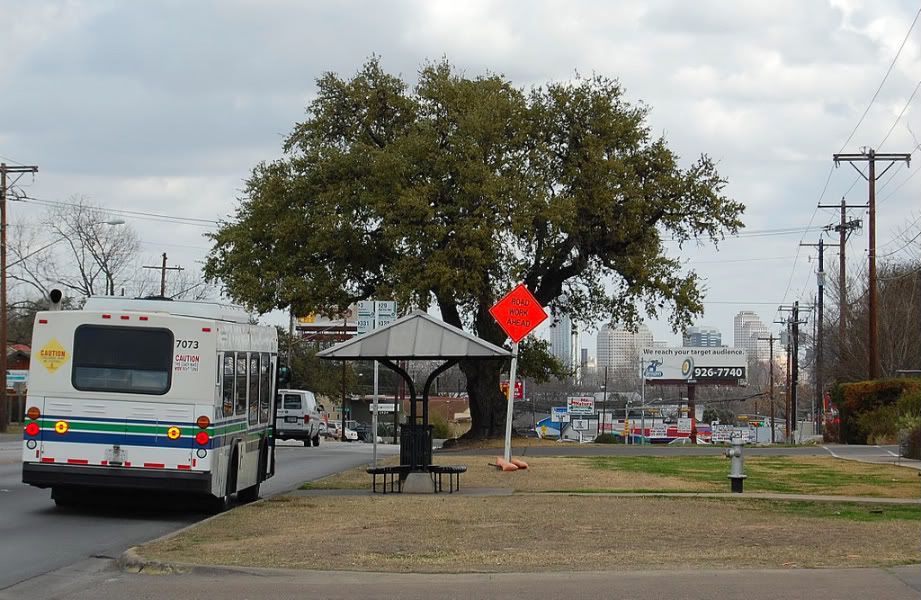
04. Closer view. Beautiful skyline with tacky billboards
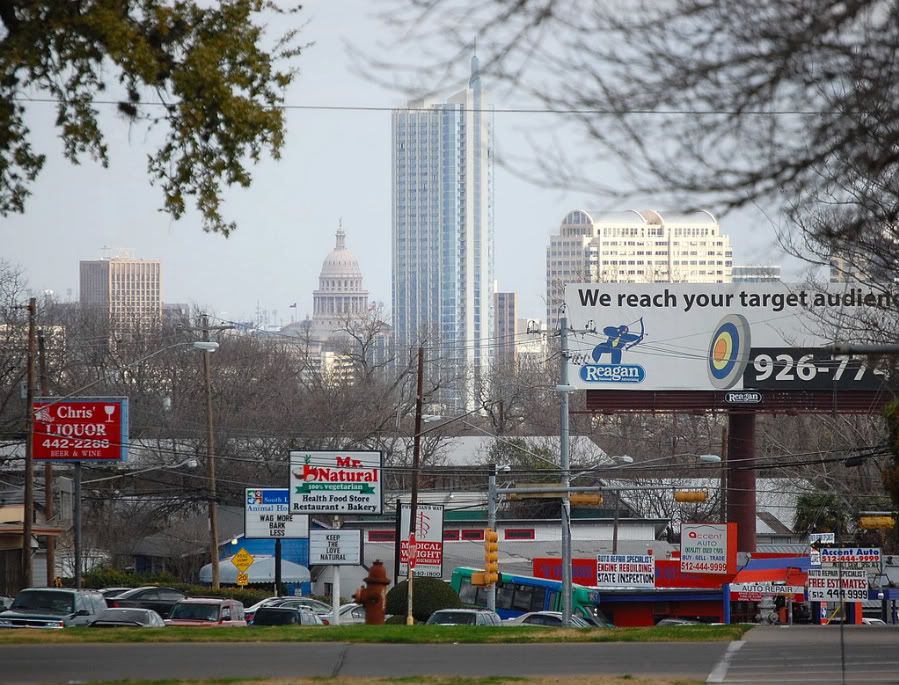
05. Maria's Taco Express on South Lamar Blvd.
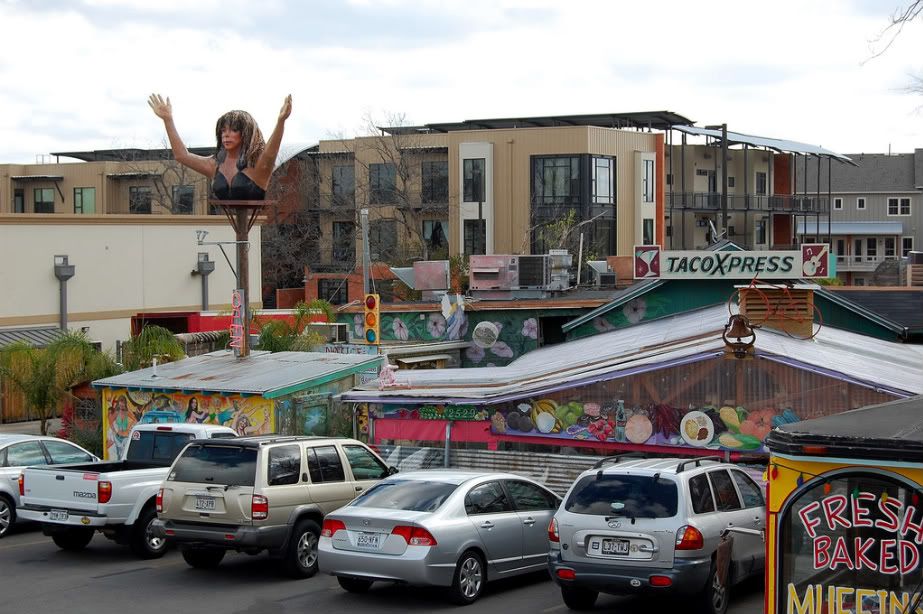
Maria's has been around awhile. A few years ago, Walgreen's (far left) decided to build a new store and as part of the project, I believe they tore down the original restaurant and built the current one for Maria. The condo behind Walgreen's is called Spaces 2525. It gets its name from its' address - 2525 S. Lamar Blvd.
06. Another view of Maria's with Spaces 2525 in the background

Austinmama.com had a
2001 article about the owner, Maria Corbalan. When she first moved here in 1982 (same year as me) she couldn't speak English. More about Maria's Taco Express from the article:
This is Maria's third business in eight years at the present location -- a Mexican gift shop went by the wayside (anyone remember Curiosity Killed the Cat?), along with a convenience store, Sugar and Spice. She opened a little trailer on the spot four years ago to the chorus of Are you crazy? from friends. You’re next to Matt’s El Rancho and Kerbey Lane and you’re going to open up a shack with five tables? they chided. Initially, it looked like they might be right: 17 dollars a day wasn’t going to cut it. But three months into Taco Express, the Austin American Statesman did their first article on her, and she watched her sales jump to 300 dollars a day
07. Muffins and Mate - off to the side of Maria's Taco Express
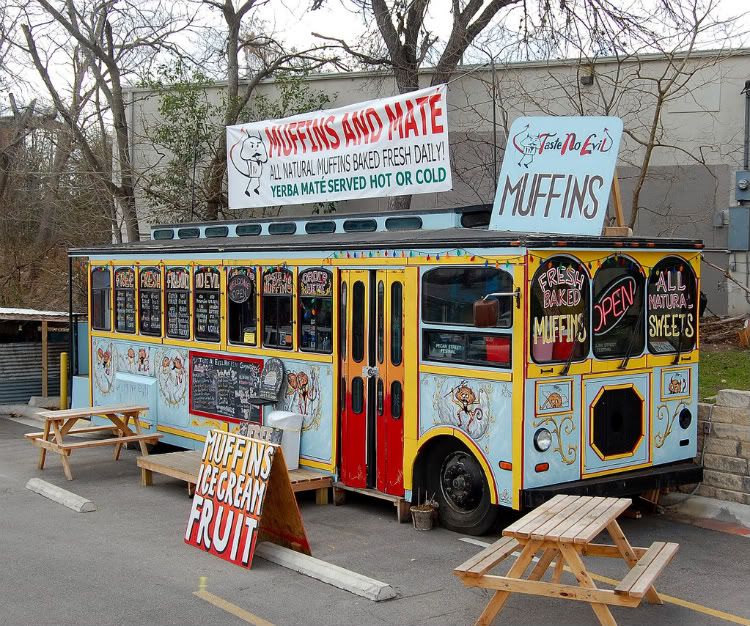
08. Coffee Stand between Maria's and Spaces 2525
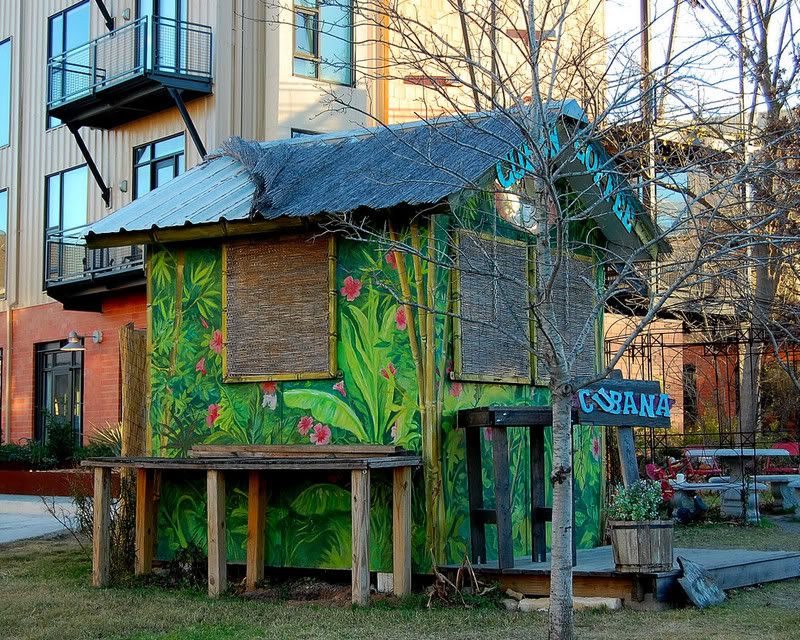
09. Looking inside Maria's Taco Express

10. UT Tower, Dobie Tower, Spring, Wells Fargo and Monarch from third floor stairwell of Spaces 2525.
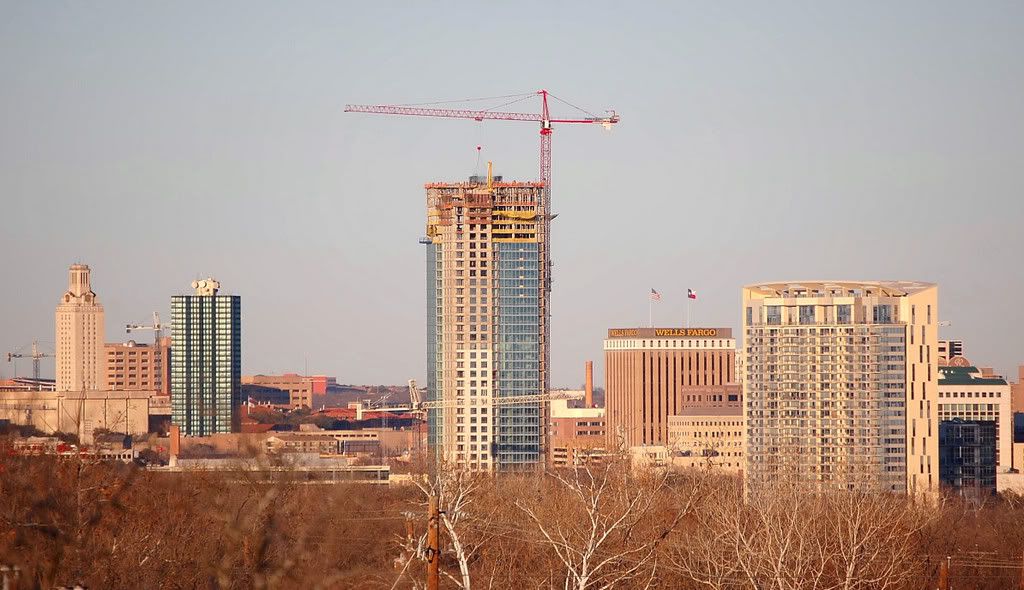
11. South Lamar Bld. with 300 W. Sixth, Chase Tower and One American Center. Taken from Capital Metro's #3 bus.
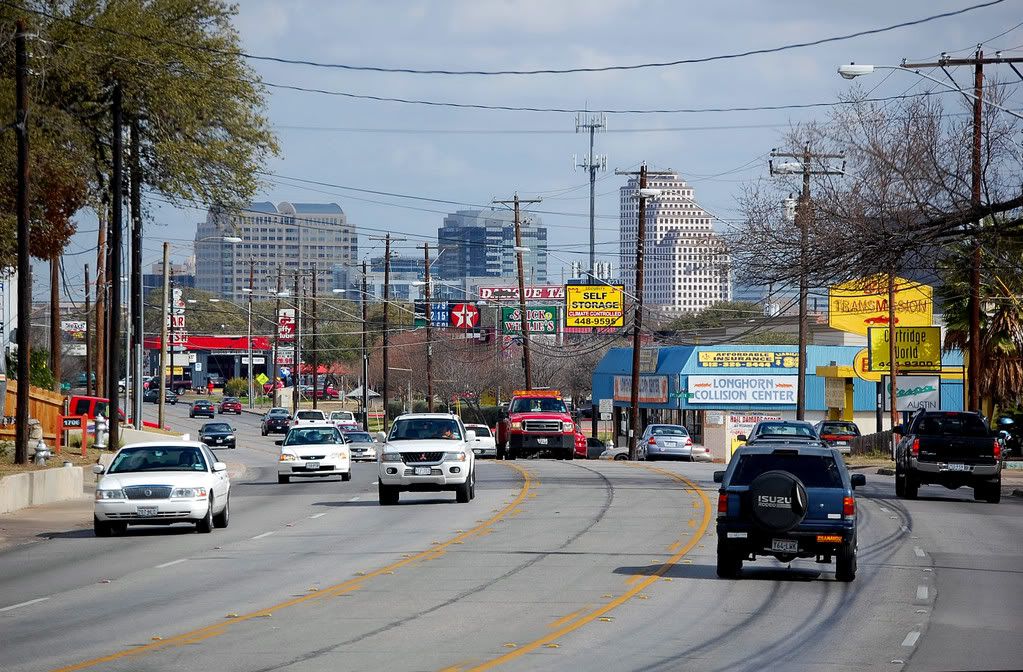
12. South Lamar Blvd. and 360 Condominiums from the #3 bus
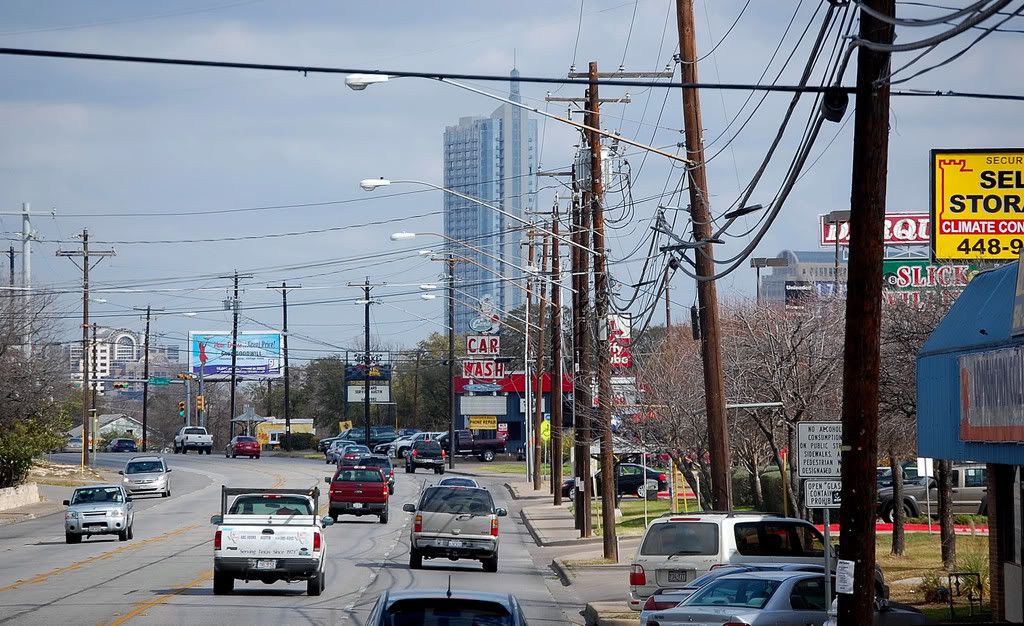
13. Spring from the #3 bus near Lamar Square

There are a couple of skyline vantage points from this particular stop at S. Lamar and Lamar Square. On the right (east side of Lamar) is a vacant lot that's the site of another failed condo project called the Magnolia.
14. Partial skyline view from the Magnolia site:
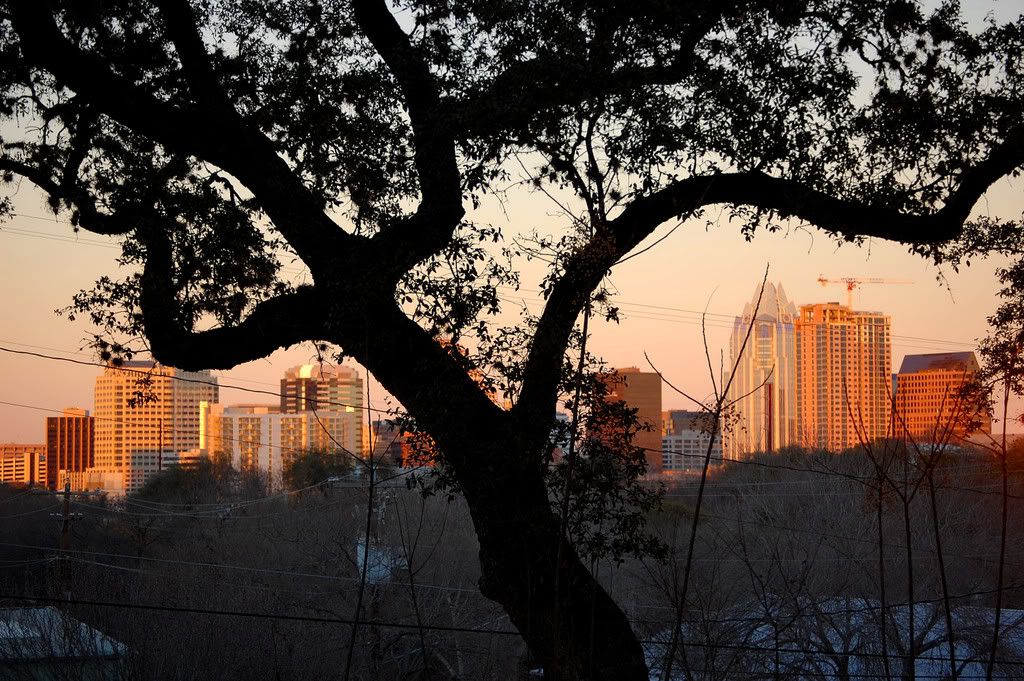
The Magnolia would have been a five-story condo, but was cancelled. You can't really get a clear view of the skyline but you can see it through the trees.
15. Partial skyline view from the Magnolia site
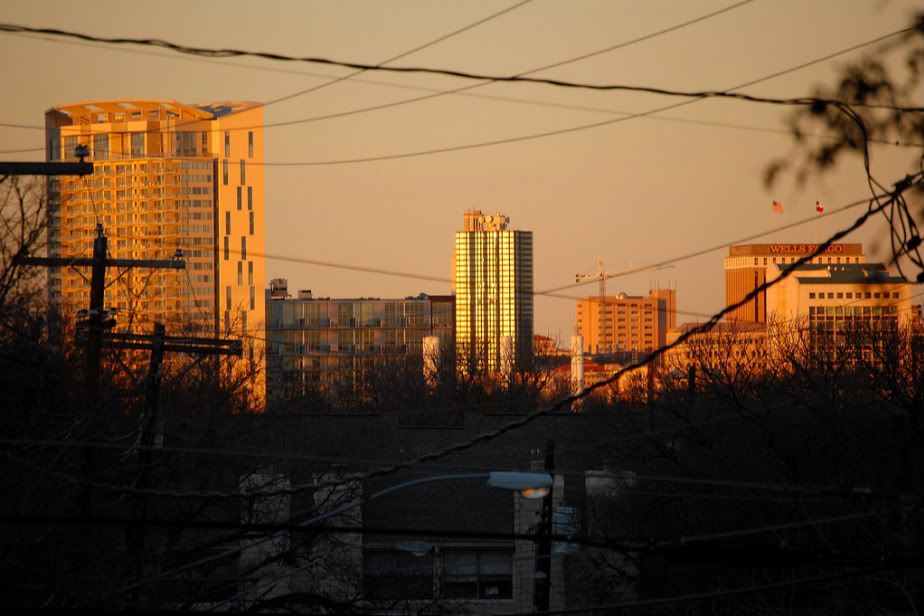
The condos on the upper floors of this failed project would have had spectacular views.
16. A wider skyline view (including 360 Condominiums) from the Magnolia site
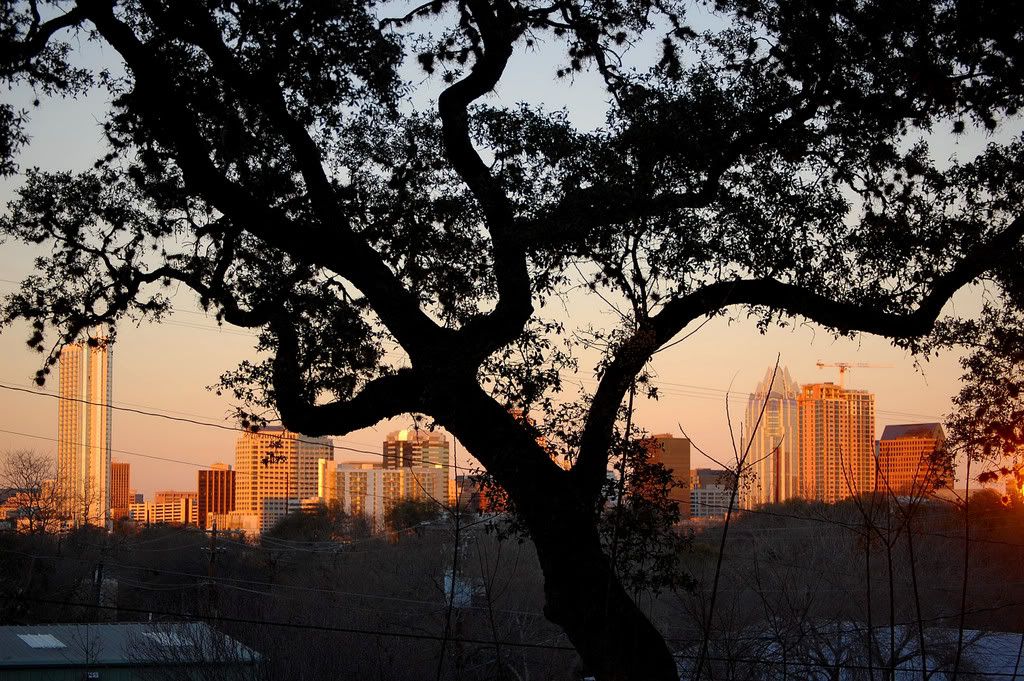
Across the street, on the west side of South Lamar is Lamar Square Shopping Center - a good place to photograph the skyline from
17. Skyline from Lamar Square
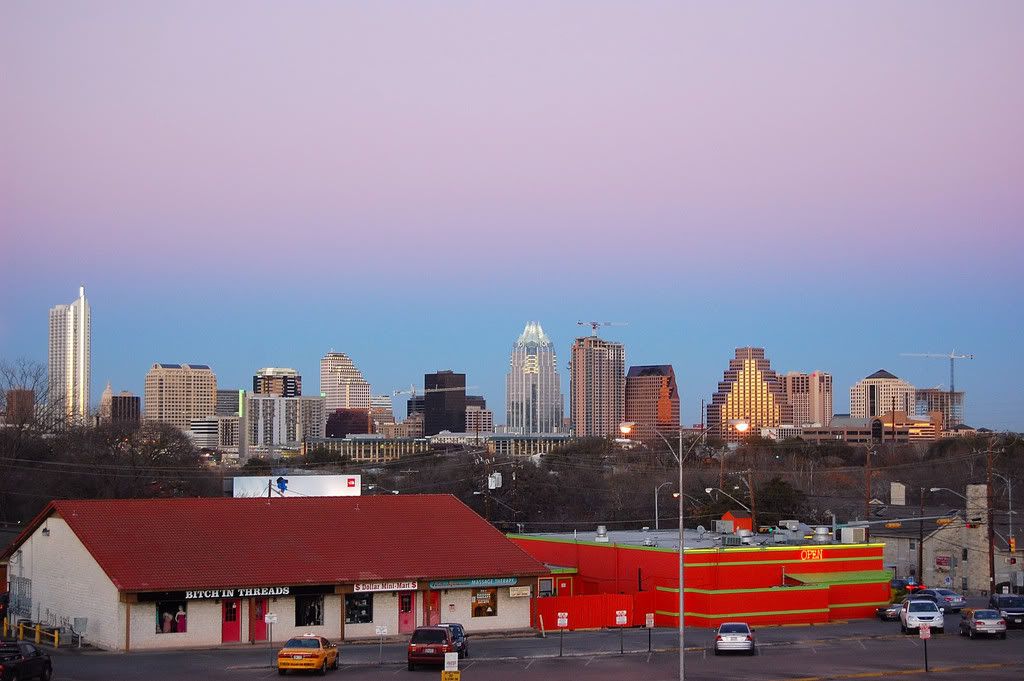
18. Monarch from Lamar Square
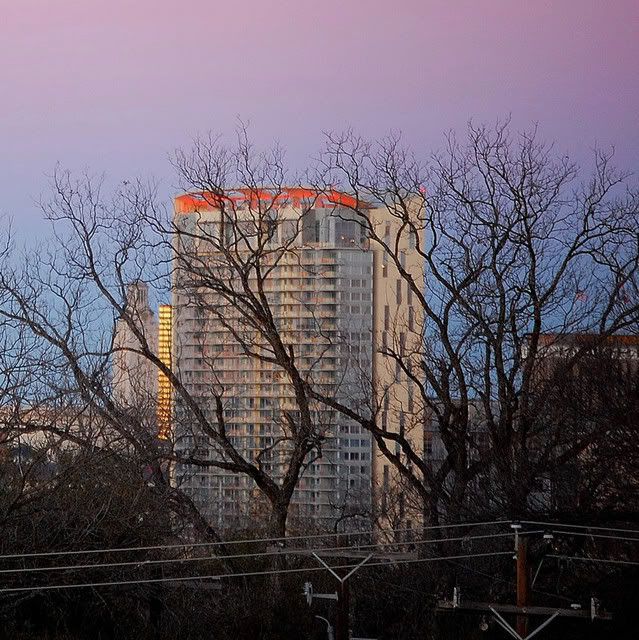
19. San Jacinto Tower and Four Seasons Residences (under construction)
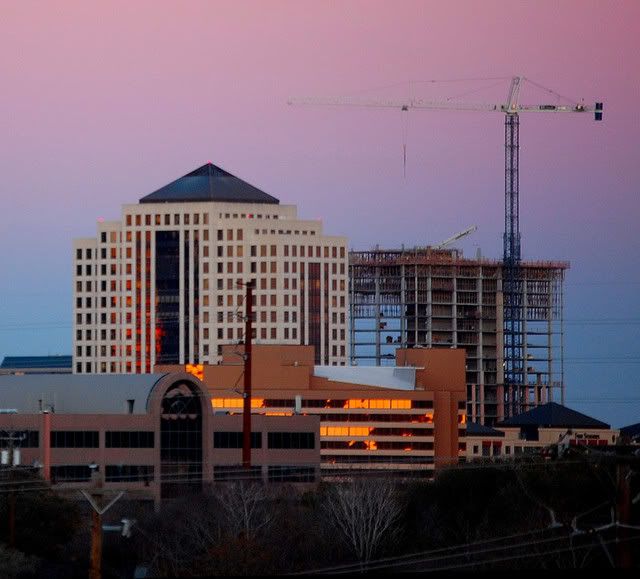
20. Spring and Monarch from Lamar Square
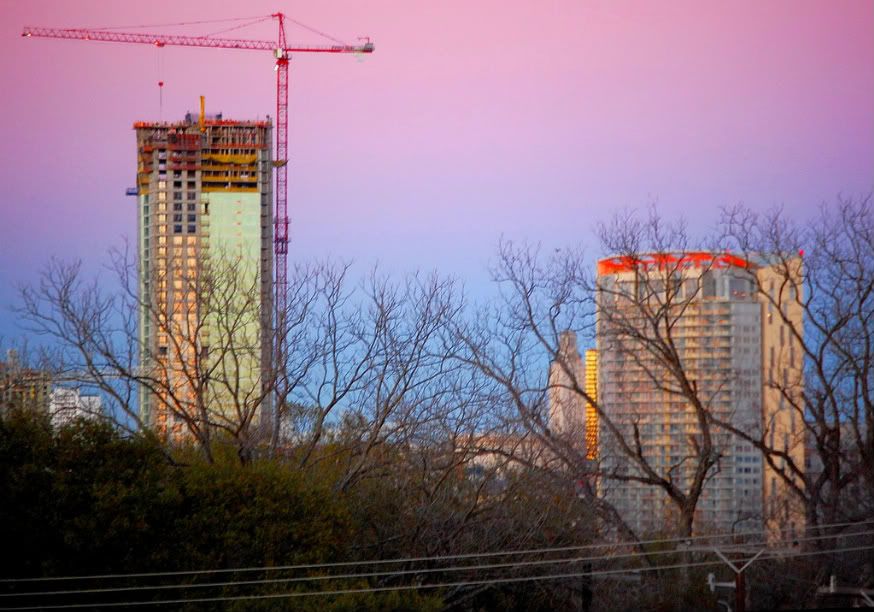
21. One Congress Plaza, Hilton Convention Center Hotel, San Jacinto Tower and Four Seasons Residences (under construction)
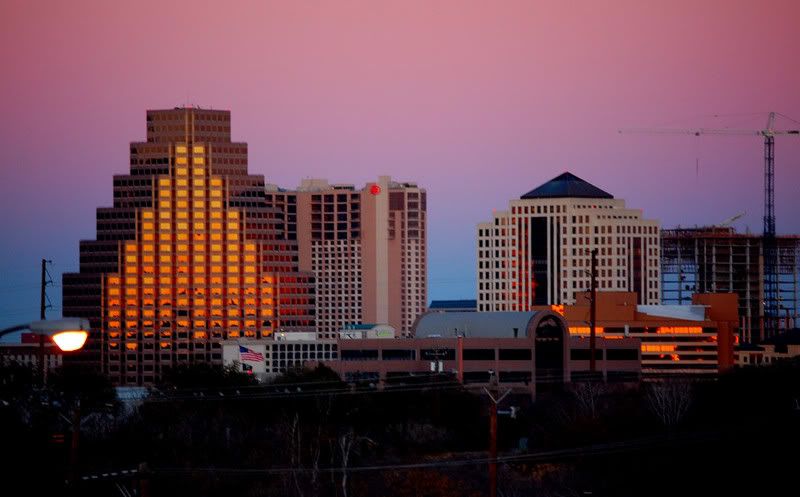
22. Artsy-fartsy skyline shot

Back on the #3 bus headed downtown
23. 360 Condominiums from the #3 bus
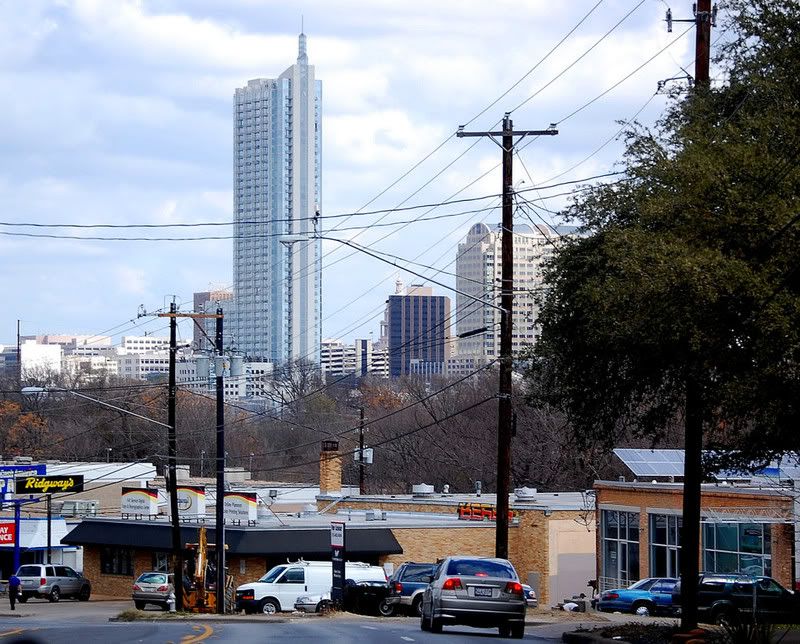
24. Approching Lamar and Barton Springs on the #3 bus. Spring and Monarch are in the distance

25. 300 S. Lamar Blvd (apartments) at Lamar and Barton Springs. The apartments were built on the former site of the Binswanger Glass Company.
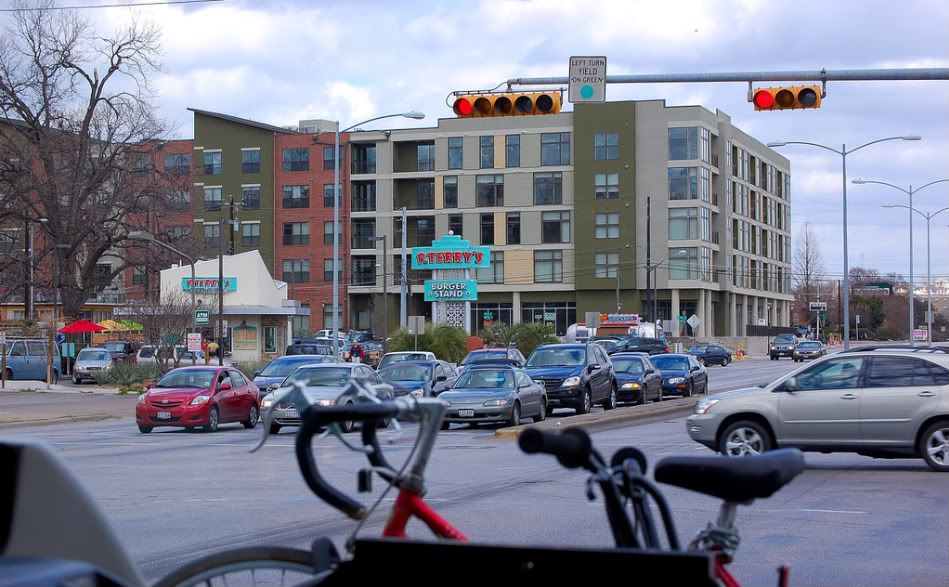
26. Exiting Lamar Blvd onto Cesar Chavez near the Gables site (8-story apartment building with ground floor retail)
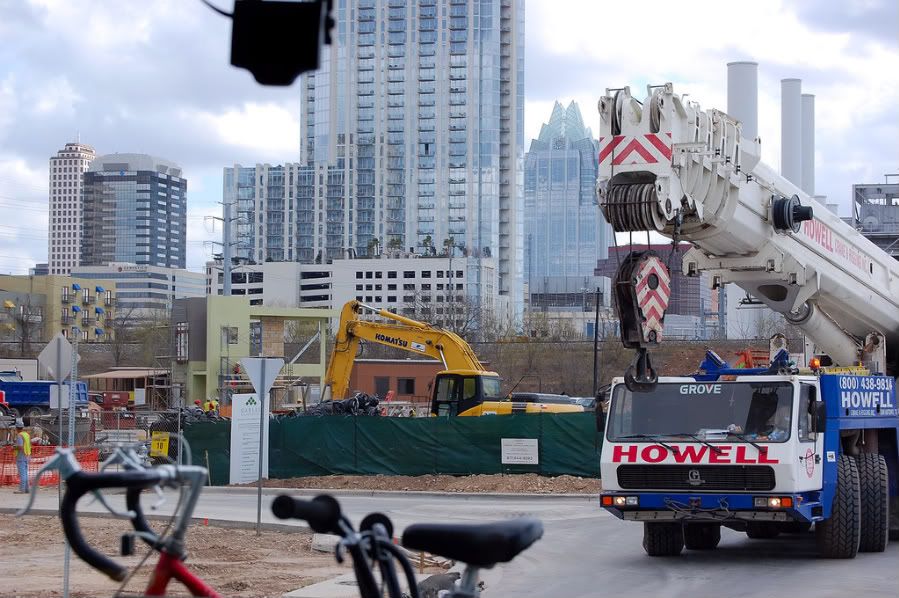
27. Cesar Chavez Street from the #3 bus. Austonian, Ashton, 100 Congress and San Jacinto Tower in the distance.
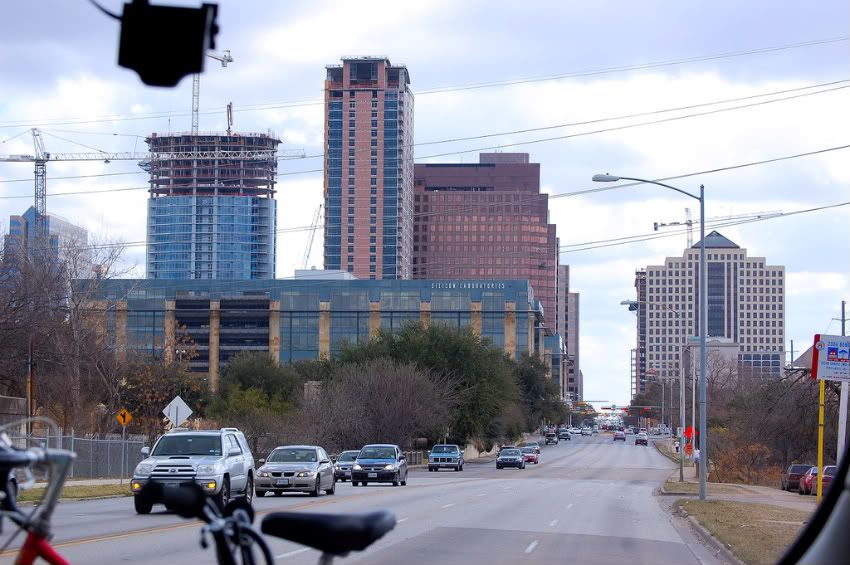
28. Now we'll head up Congress Avenue towards the State Capitol.
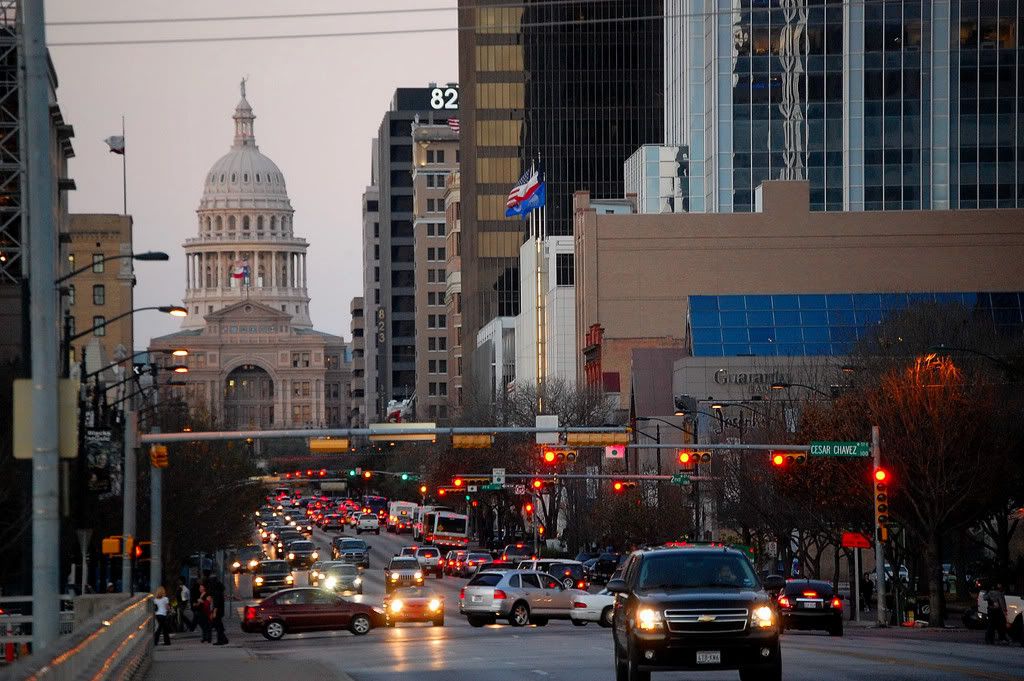
Historical street and building information is from the Austin Convention and Visitors Bureau brochure (Historical Walking Tours: Congress Ave. & E. 6th Street) as well as other sources.
All downtown north/south streets (except Congress Avenue) are named after Texas rivers with their order of placement matching the order of rivers on the Texas state map. Although Edwin Waller, who surveyed the site for the new capital city and oversaw its planning and construction, recommended that the east-west streets be numbered, they were originally named after native Texas trees. They were changed to numbers in 1884. (One exception was 1st Street. It has since been renamed Cesar Chavez Street.) Edwin Waller was also Austin's first mayor and Waller Creek is named after him.
Congress Avenue was designed to be Austin's most prominent street. Early structures along Congress Avenue included government buildings, hotels, saloons, retail stores and restaurants. By the late 1840's "The Avenue" formed a well-established business district. The mid 1870's introduced gaslight illumination and mule-driven streetcars. The original dirt street was bricked in 1910. Trolley cars operated on Congress Avenue until 1940.
29. One Congress Plaza.
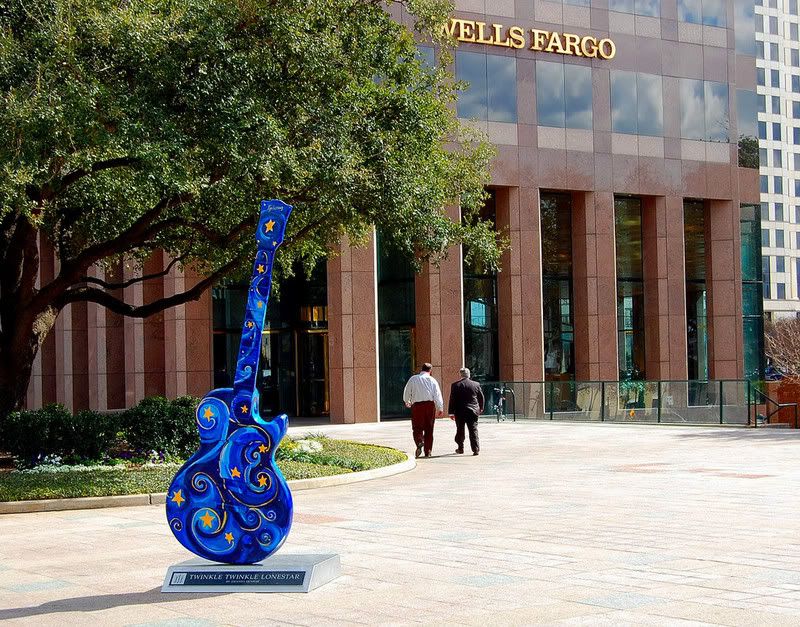
Note the guitar. There are a few more on Congress Avenue and in other parts of the city. This one is called "Twinkle, Twinkle LoneStar."
30. The sunken plaza at One Congress Plaza. The building is on the east side on Congress Avenue between Cesar Chavez and 2nd Street which was originally named Live Oak Street.
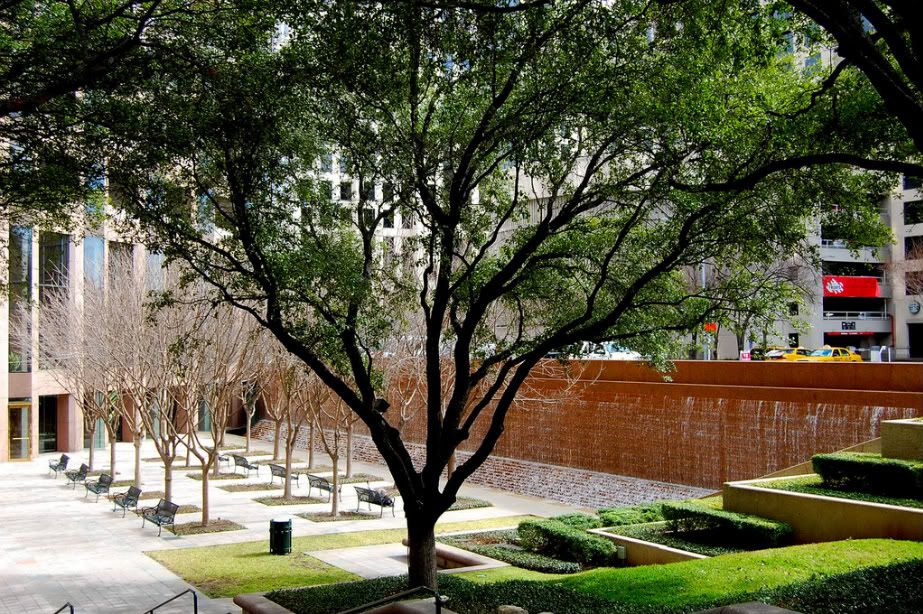
31. On the west side of Congress Ave.between Cesar Chavez and 2nd Street is 100 Congress and the Ashton. Between 2nd and 3rd Streets is the Austonian. Photo below is all three buildings taken from 3rd and Brazos.

32. Old Advertising. The vacant lot in the foreground used to house a Tesoro's Trading Company, Las Manitas Mexican Restaurant and the Escuelita del Alma daycare center. Tesoro's moved down to South Congress, Las Manitas is supposed to reopen on the southeast corner of Congress and 3rd St. and Escuelita del Alma moved to the Mueller development. The buildings were razed to make way for a 1000-room Marriott Convention Center Hotel. The hotel is still planned, but I believe construction has been postponed for now due to the economy.
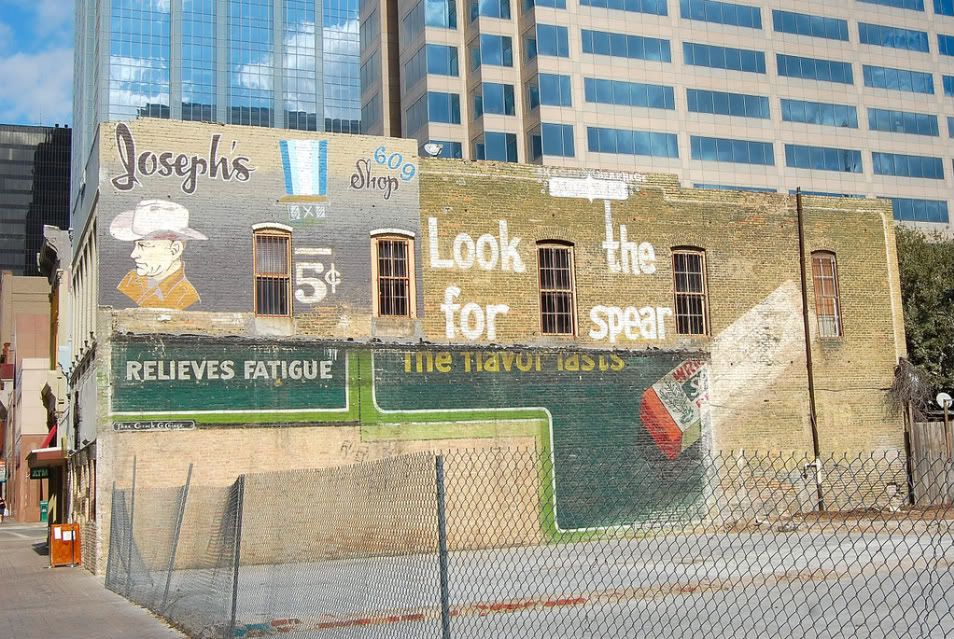
33. A mural before the buildings were razed.
photo taken October 31, 2007 It has been relocated to 3rd Street between Congress and Brazos.

34. Corner of Congress and 3rd Street, which was originally named Cypress Street. Frost Tower and 301 Congress are the two highrises.
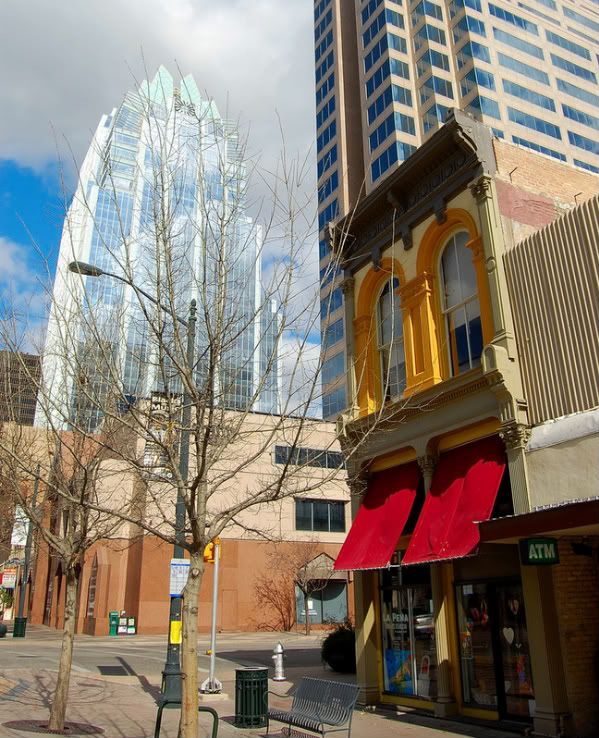
The old building above on the southeast corner of Congress at 3rd was built in 1883. It was originally known as the Pearl House Saloon. This is where Las Manitas is supposed to move.
35. Old Pearl House Saloon. In 1885, you could buy tickets for your train here in Hermann Schmidt's saloon and relax until your coach departed from the station four blocks east. Touted as the most convenient hotel to the railroad, the upstairs area provided rooms. Only the northern half of the building survived a 1950's fire that consumed the southern half.
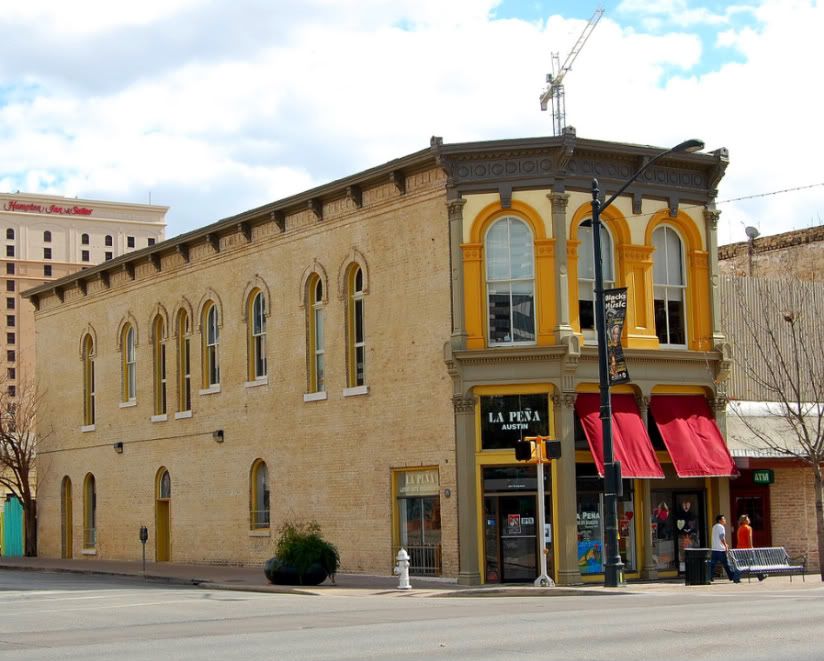
36. On the northeast corner of Congress and 3rd is 301 Congress Avenue. My bank's main branch is in the lobby. Looking out through the Congress Avenue exit, you can see the Hobby Building and 360 Condominiums.
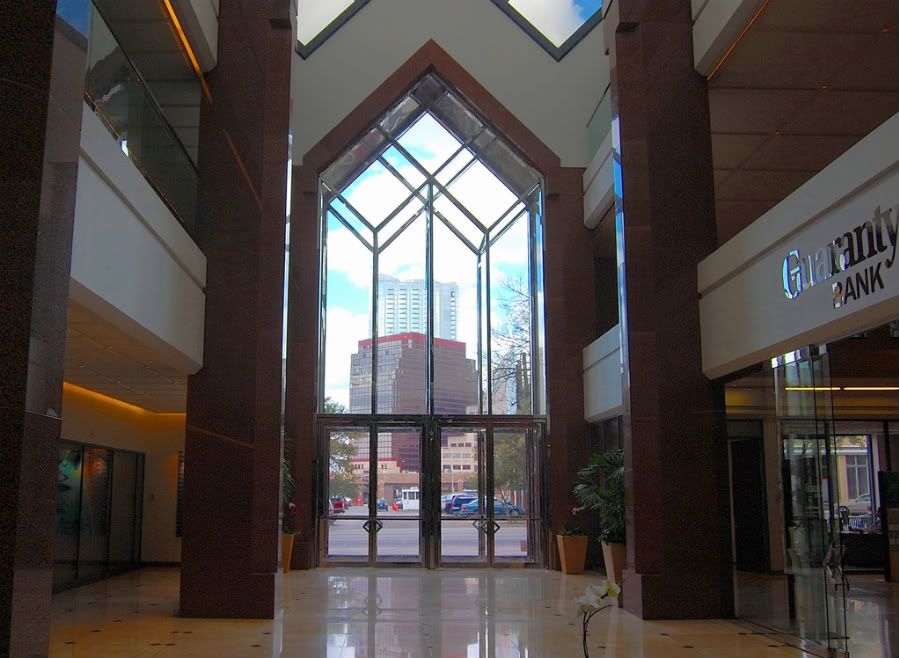
When 301 Congress held its grand opening in November 1986, developer Trammell Crow Company displayed artifacts recovered during excavation of the construction site. Attendees marveled at items ranging from two square brown bottles marked "Dr. J. Hostetter's Stomach Bitter" to a 17,000=year-old mammoth bone. Some of the artifacts are displayed in a glass case in the corridor that connects the main lobby at the Congress Avenue entrance to a smaller lobby at the Brazos Street entrance.
37. Across the street on the west side of Congress between 3rd and 4th are several older buildings. The Mexican restaurant is Manuel's.
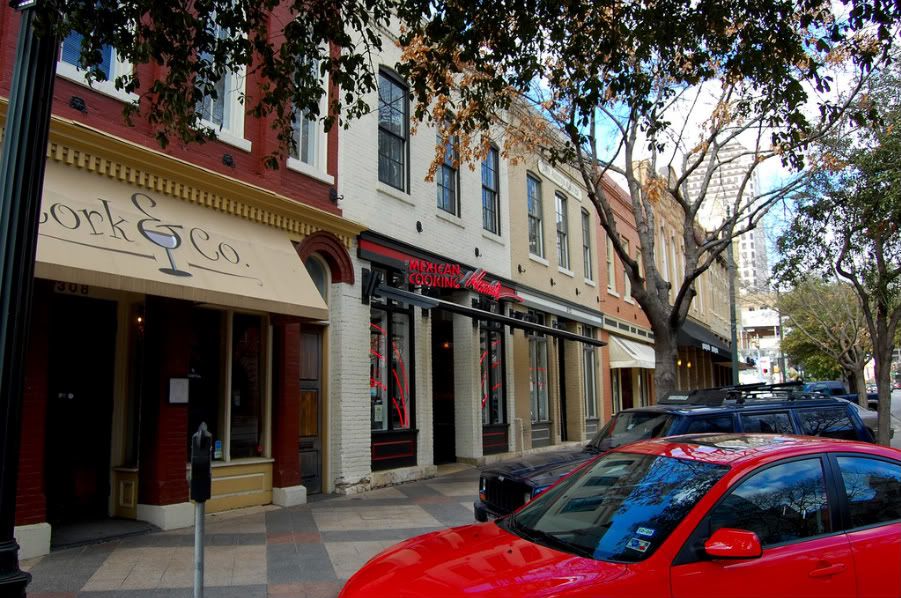
38. Further north on the southwest corner of Congress and 4th is the Koppel Building, built in 1888
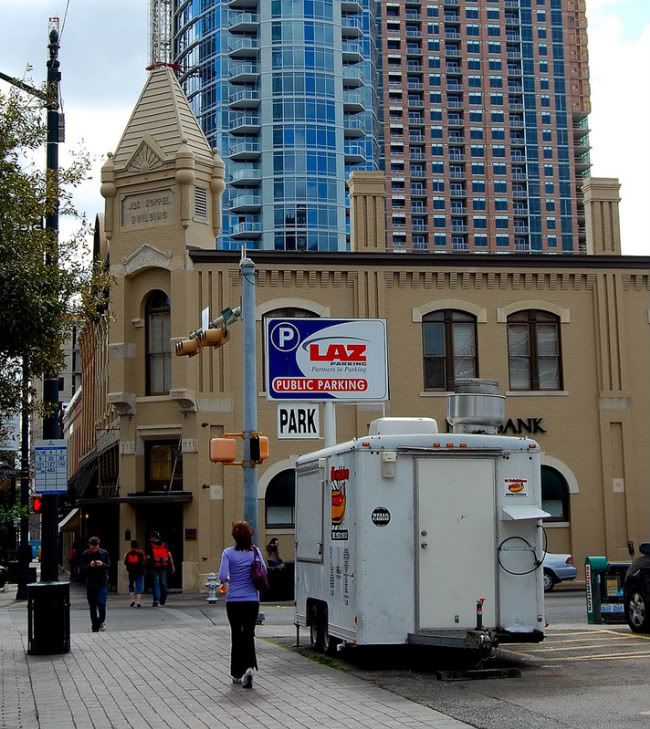
39. Congress at 4th Street, which was originally named Cedar Street. The building with the clock on the corner is 327 Congress and was built in 1984. The red building next to it is the McKean-Eilers Building, built in 1897. When it was built, McKean-Eilers was the only wholesale dry goods firm in Austin with an office in New York City. Further south down the block is 301 Congress.
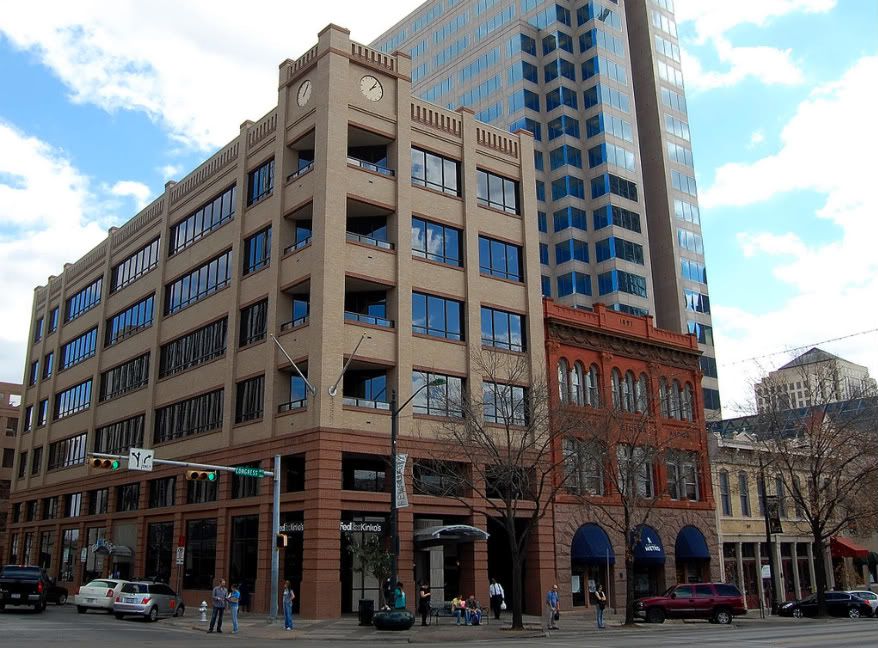
.
40. Corner of Congress at 5th, which was originally named Pine Street. The old red building is the James H. Robertson Building. Robertson practiced law and was later a judge, but I have no idea when this building was actually constructed. It's not referenced in the Congress Ave. walking tour and I couldn't find out any info by searching online.
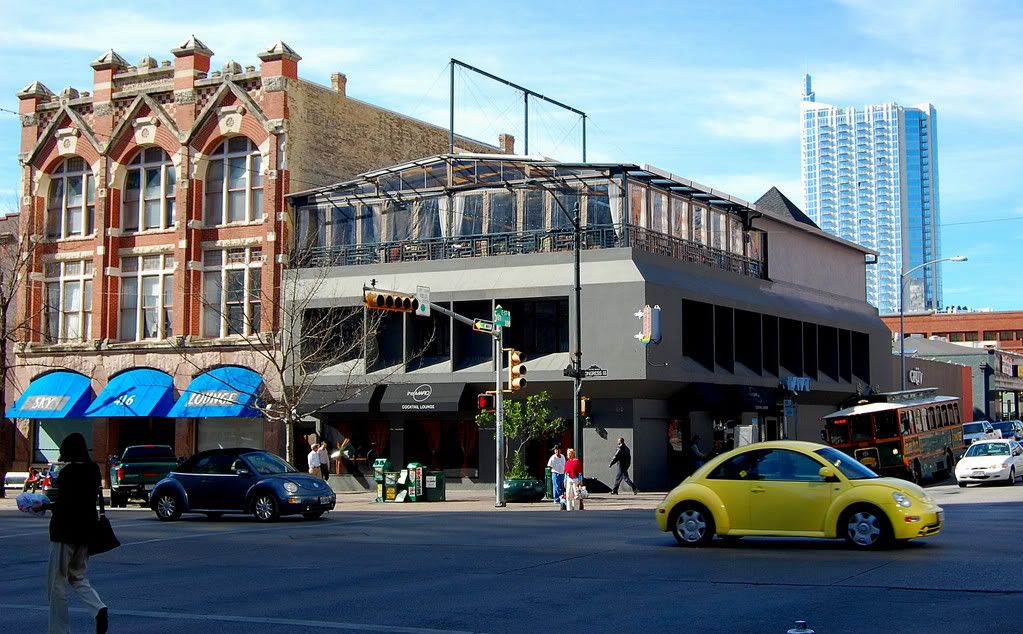
41. Another guitar on Congress Avenue between 5th and 6th. This one is called "Vibrancy."
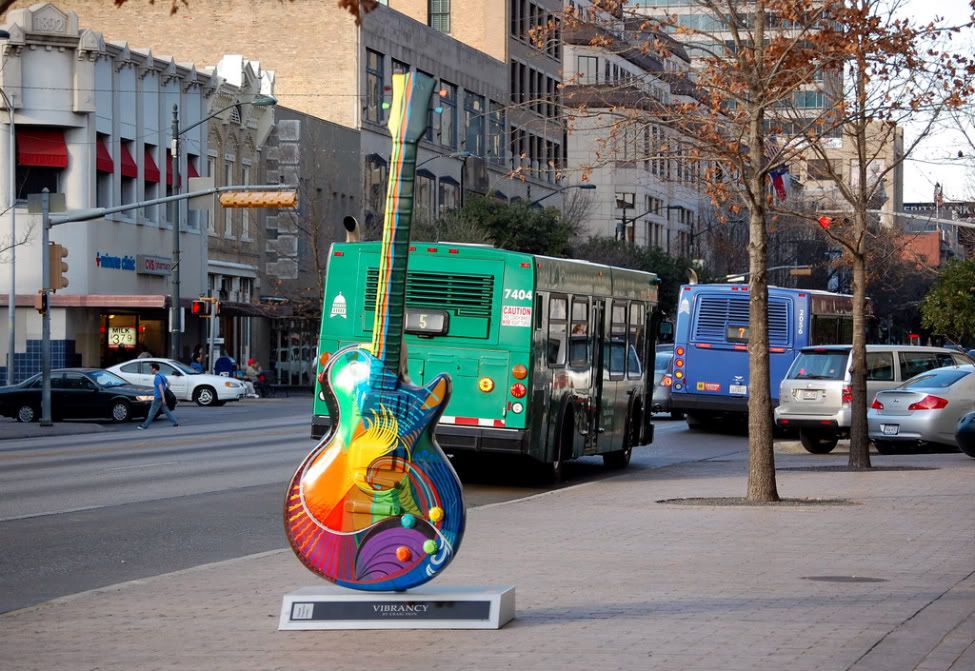
In the above photo, note the CVS pharmacy on the corner. The small building to its right is the Robinson-Rosner Building. Fancy groceries were sold from this building in the last half of the nineteenth century while a dry goods store operated here after 1903. Built in 1856, it is the oldest known building on Congress Avenue.
42. Approaching Congress at 6th Street, which was originally named Pecan Street. The black highrise on the right is the Bank of America Building. When I moved here in 1982, it was known as the Austin National Bank Building. Further north is the Littlefield Building, The Stephen F. Austin Intercontinental Hotel, and 823 Congress.
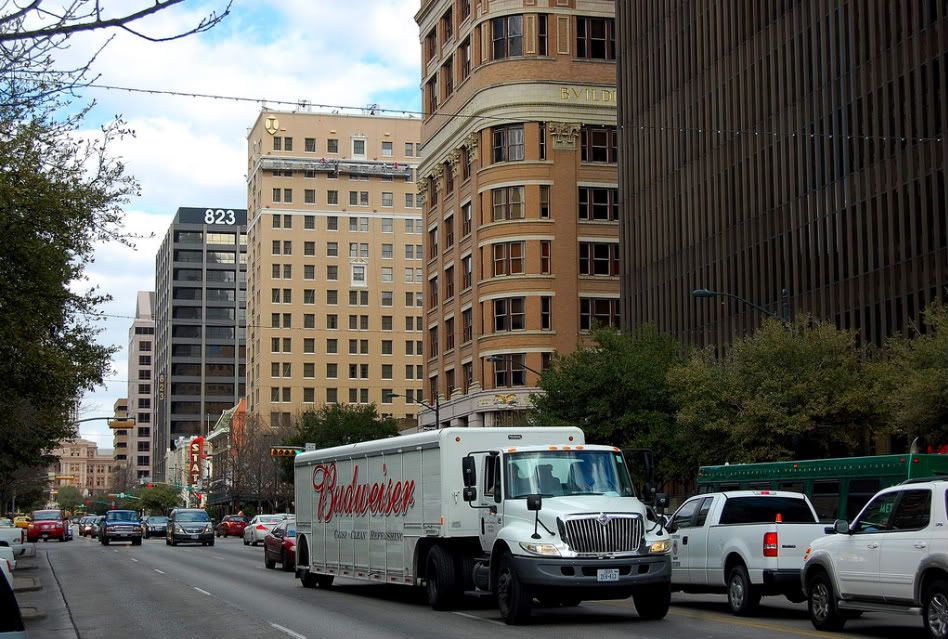
43. Littlefield Building at Congress at 6th.
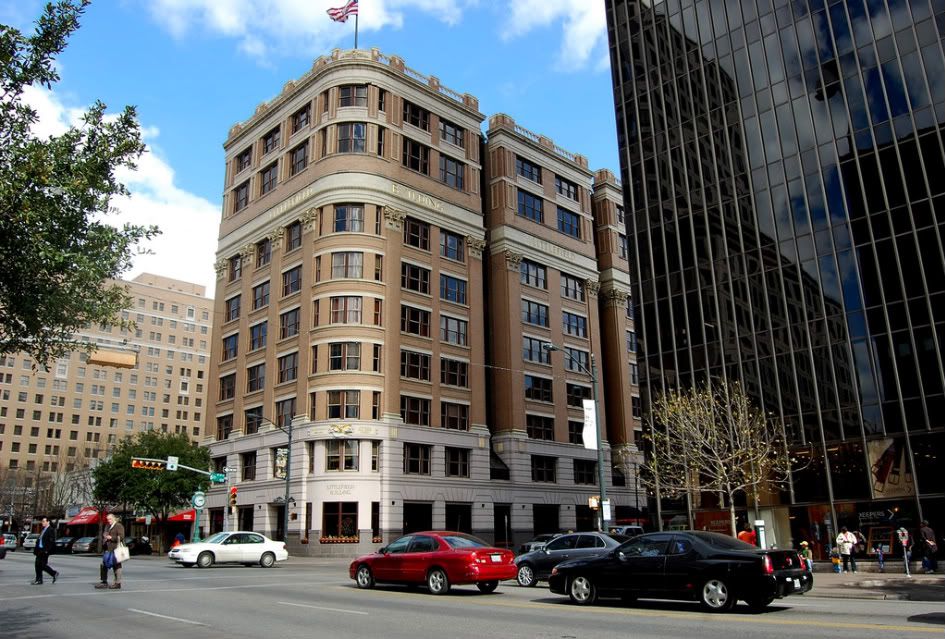
More info on the Littlefield Building from the Austin Convention and Visitors Bureau:
Designed by local architect C. H. Page, Jr. and built under the direction of the flamboyant Major George Washington Littlefield (a Civil War hero, rancher, banker and University of Texas benefactor) this building was one of the most opulent and modern structures in the country at the time of its completion in 1912. Originally built with eight floors, Major Littlefield added another floor when the Scarborough Building, a rival structure, reached eight floors. For a short while, the nine story Littlefield Building was the tallest building between New Orleans and San Francisco.
44. A view of the Scarbrough Building, with One American Center taken. from the Frost Bank Garage.
photo taken November 27, 2007
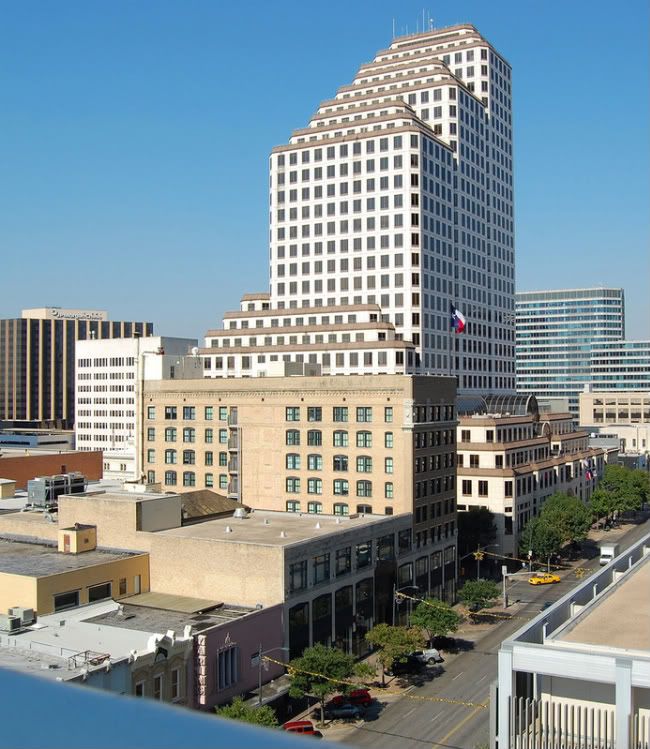
More info on the Scarborough Building, constructed in 1909, from the Austin Convention and Visitors Bureau:
In this building merchant E. M. Scarbrough established what would become the finest department store in Texas during the early twentieth century. Designed in the Chicago style by the Fort Worth architectural firm of Sanguinet and Staats, "Scarbrough's", as it was locally known, was enlarged in 1916 with the south addition and a full basement. In 1931, the exterior was redesigned in the Art Deco style. Today only the cornice and upper floor windows reveal the building's Chicago style origins. In 1839, this site sold for $2,800, the highest price paid for any lot in Austin during the original auction of city lots.
45. Austin Duck Adventures.
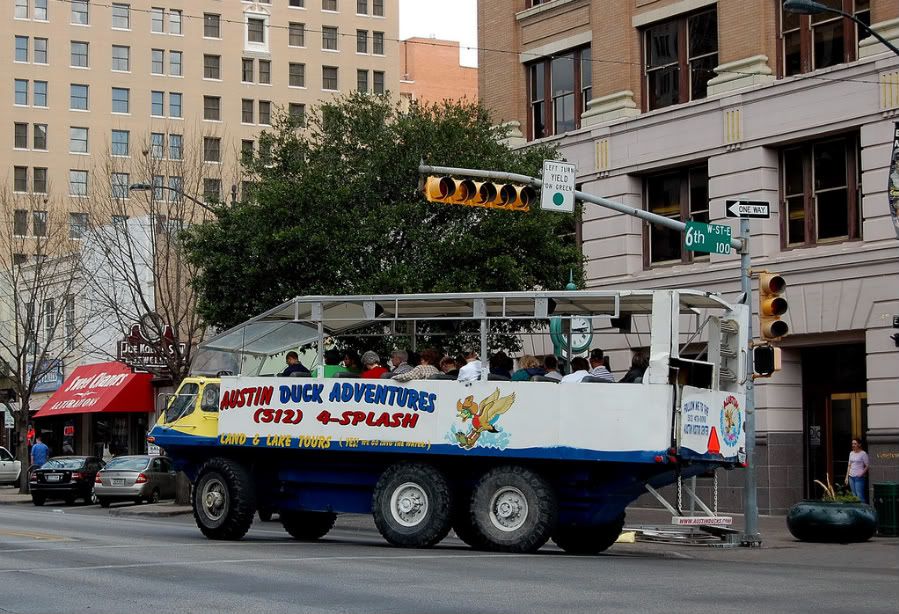
46. Yet another guitar called Sixth String. This one is in front of One American Center. At 395 feet, One American Center was Austin's tallest building from 1982 until 2004 when the Frost Tower at 401 Congress was completed.
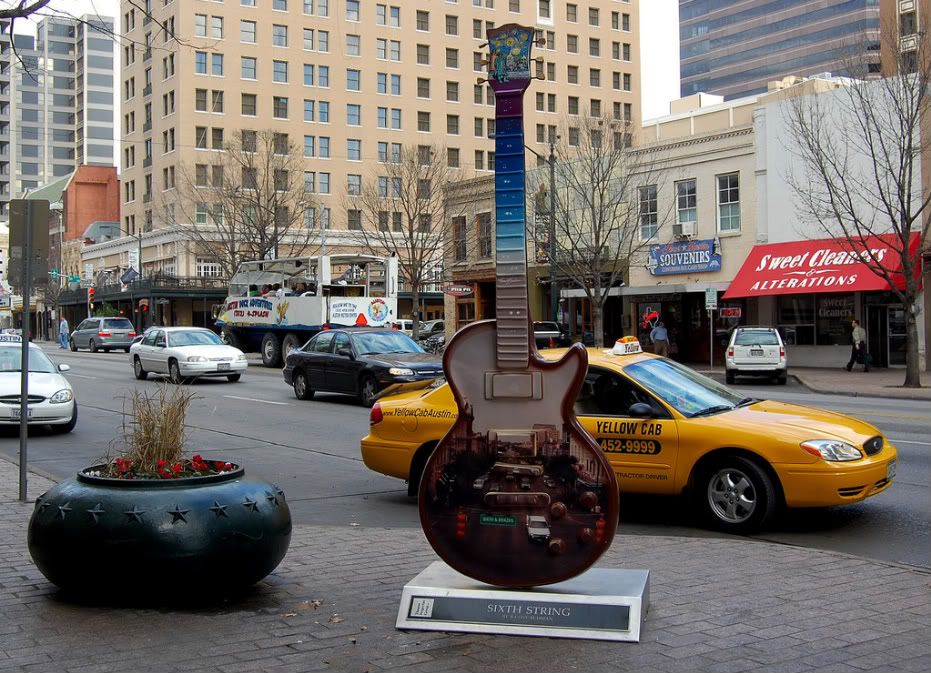
47. Statue of Angelina Eberly in front of One American Center.
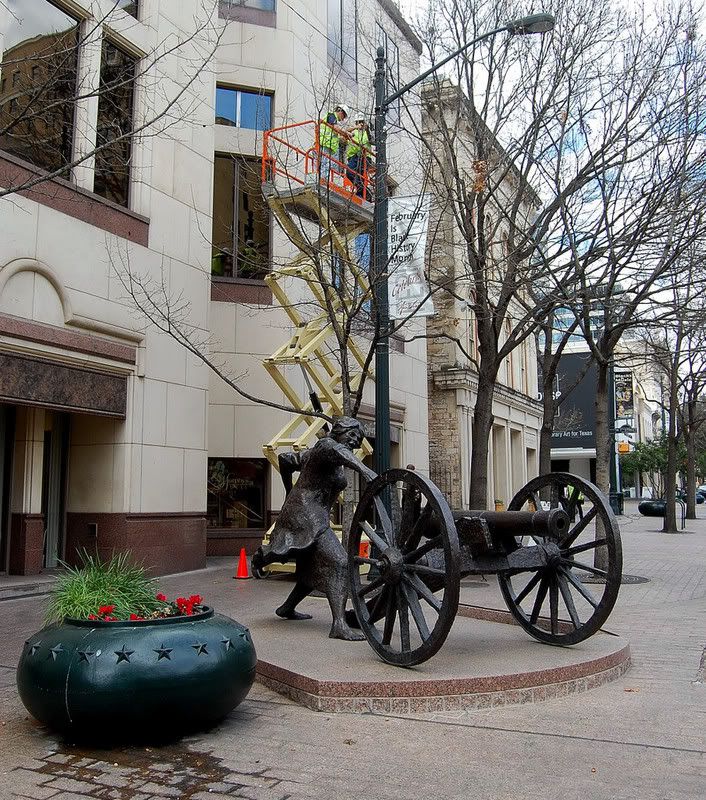
More info on Angelina Eberly from the
Texas State Library & Archives Comission:
The early Texas republic faced many decisions, including choosing a site for a permanent capital. The Texas Congress favored searching for a favorable location in Central Texas and building a planned city. Sam Houston, the first president of the Republic, blocked this plan; the president preferred that the capital go to Houston, his own fledgling namesake city on the Gulf. The choice remained in limbo until 1839, when Mirabeau B. Lamar replaced Houston as president and pushed the Central Texas plan. A site was chosen along the Colorado River near the tiny settlement of Waterloo.
Within the year, Lamar had moved to the new capital, now called Austin, and Congress was meeting in log buildings in the frontier town. Forty wagons carried the government archives from Houston to their new home. Over the next several years, the archives would become a highly visible symbol of a tug-of-war for government power in Texas.
In 1841, Sam Houston again became president. He often described Austin as "the most unfortunate site on earth for a seat of government," and refused to move into the official residence, preferring instead to take a room at a boarding house run by Mrs. Angelina Eberly.
The next year, Houston saw his chance to move the capital back to the city of Houston. The Mexican army invaded Texas and took control of San Antonio, Goliad and Victoria. The president called a special session of Congress to meet in Houston, arguing that Austin was defenseless against Mexican attack. He also ordered the secretary of state to remove the archives back to Houston. The citizens of Austin were determined to prevent the move. They formed a vigilante "Committee of Safety" and warned the heads of government in Austin that any attempts to move the official papers would be met with armed resistance.
In December 1842, Houston announced that Austin was no longer the capital and ordered Colonel Thomas I. Smith and Captain Eli Chandler to Austin to remove the archives. Smith and Chandler and 20 men loaded three wagons without incident before being spotted by Mrs. Eberly. She fired a cannon to alert the citizens of Austin.
Smith and Chandler fled with their wagons, with the vigilantes in hot pursuit. At Brush Creek in Williamson County, just north of Austin, Chandler and Smith were forced to surrender at gunpoint. The archives were returned to Austin, where the citizens celebrated with a New Year's Eve party. The government itself did not move back to Austin until 1845 and the question of the location of the Texas capital was not completely settled until 1850, when Texans voted by a large majority to make Austin the permanent seat of government.
In 2004, the statue commemorating the event (known as
The Archives War) was installed at roughtly the same place where the original cannon once stood. The reason for the cannon on Congress Avenue back then was to warn Austin citizens in case of an indian attack.
48. Looking back down Congress Avenue towards Cesar Chavez and Lady Bird Lake. The Austonian and Ashton are the two highrises in the distance. Closer in is the Scarbrough Building, followed by the base of One American Center. The small three story building on the far right is the Sampson-Henricks Building.
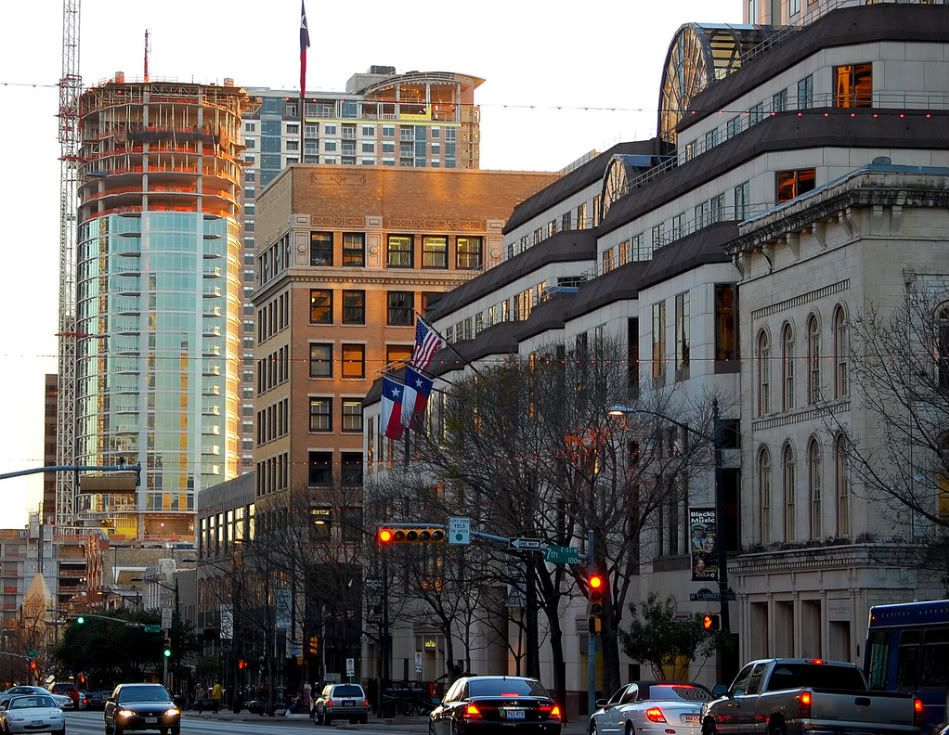
49. Sampson-Henricks Building. Built in 1859, it is one of the oldest buildings on Congress Avenue.
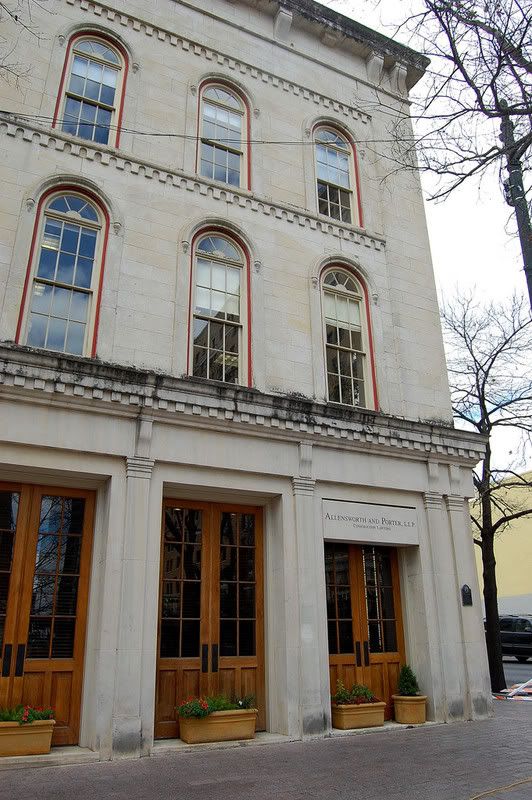
50. Stephen F. Austin Intercontinental Hotel at the corner of Congress at 7th Street, which was originally named Bois de Arc Street.
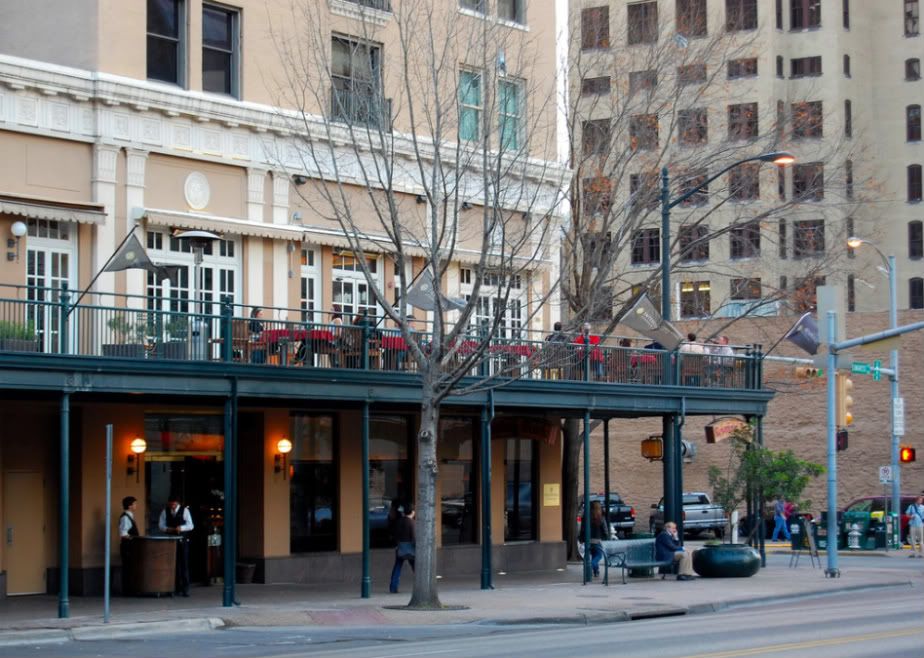
The hotel was first opened in May of 1924 with an additional five floors added by 1938. Named after the famed Texas colonist, Stephen F. Austin, the hotel was designed with the latest technological advances and highest standards of the time including running ice water, English style butler service and an on-premise beauty salon. Lyndon Baines Johnson used the hotel as his campaign headquarters in the 1960's. The property was closed in 1987 and sat vacant until 1997, when it was bought by T. Stacy & Associates. After extensive renovations, the hotel finally reopened in 2000.
51. East side of Congress Avenue between 7th and 8th. Buildings from left to right are 823 Congress, the Eugene Bremond Building, the State Theater, The Paramount Theater and the Stephen F. Austin Intercontinental Hotel.
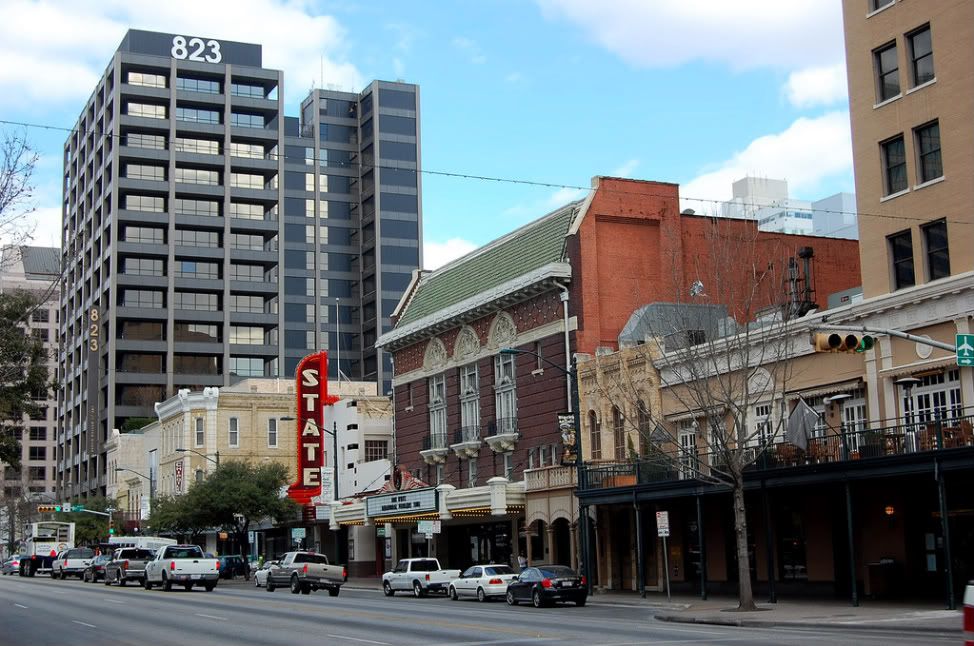
52. Closer view of the Paramount Theater and State Theater.
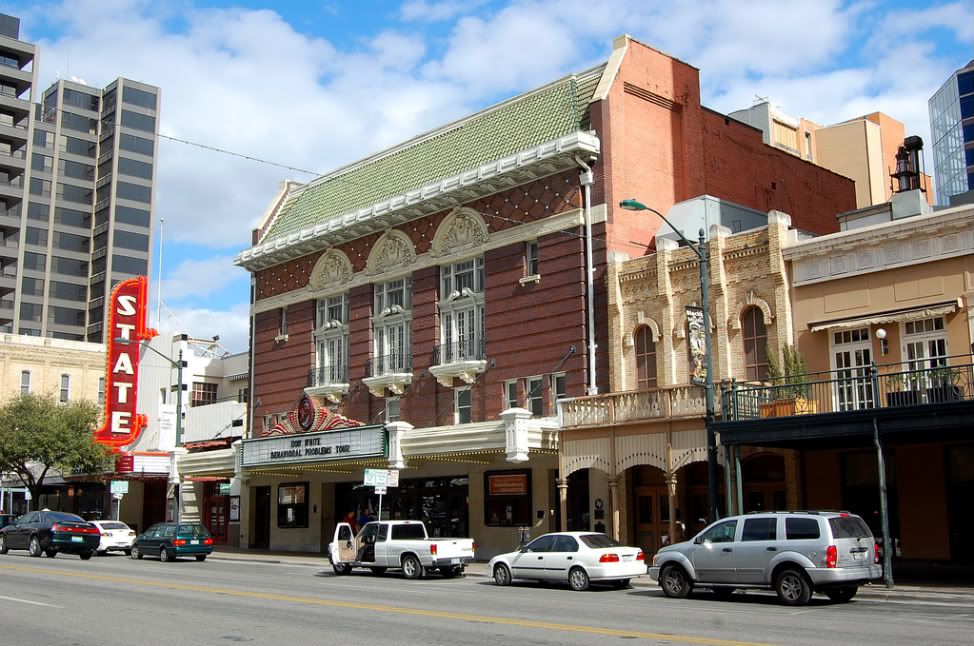
More info on the Paramount Theater from the Austin Convention and Visitors Bureau.
Designed by architect George A. Endress and built by Ernest Nalle, the Paramount Theater was originally known as the Majestic Theater. When it opened in 1915, it seated 1,600 people. With no major interior columns to obstruct views, there wasn't "a bad seat in the house." The theater has hosted such notables as Helen Hayes, Katherine Hepburn, Burt Reynolds and Dolly Parton. By 1960, the Paramount catered almost exclusively to the motion picture industry but was re-dedicated to the performing arts in 1975. In 1839, the original offices of the War Department and the Adjutant General of the Republic of Texas occupied this site.
More info on the State Theater from austintheater.org
This vintage movie house, built in 1935 stands next door to the Paramount Theatre and within sight of the State Capitol building. It was built on the site of the old Avenue Hotel which stood until after the turn of the century. The State Theatre originally served as a downtown movie house, which were popular during the era, along with many others like The Paramount, The Queen, which stood on the west side of Congress Avenue, and The Ritz, now a lounge and pool hall on 6th Street.
Designed in the Art Deco style popular when it was built, the State lobby retains much of the charm of its past. The most notable renovation to the facility stemmed from intervention by Live Oak Theatre, a local, producing theatre company. Forced to vacate its 3rd Street warehouse location, Live Oak engaged in negotiations to acquire the State Theatre because it seemed to be an ideal location for the company’s permanent home. In June 1994, the Austin City Council named Live Oak the recipient of the $1.9 million in public bond money earmarked for renovation of the State Theatre.
Designed by Austin architect Sinclair Black, the old movie house interior was transformed into an inviting, open, 320-seat space offering patrons optimum visibility and comfort. The renovation also included the construction of a new lobby, backstage work areas, dressing rooms, and a rehearsal hall. Six months later, the company finalized its purchase of the State Theatre, moved into the building and continued its tradition of presenting quality work and supporting the growth of new plays. Embracing the spirit of its new permanent home, the company changed its name to The State Theatre Company.
In 2000, the company merged with its next-door neighbor, The Paramount Theatre for the Performing Arts, to form the Austin Theatre Alliance (ATA). An endeavor that began with two distinct operational and business models has combined the best of both to become one of Austin's most uniquely productive performing arts resources - a thriving organization that both presents and produces a broad range of drama, comedy, music, dance and spoken-word events of the highest caliber, in downtown Austin's most commanding venues.
Fast-forward to June, 2006. A water main in the downtown area ruptured, flooding the State Theater. The stage, first four rows of seating and backstage were underwater. Power and phone lines were also out. The Paramount Theatre wasn't affected. I found a city document from September 2008 stating air conditioning units were being installed on the roof in order for the building to be re-opened, but haven't read anything since.
53. Paramount Theater. Notice the three limestone-carved gargoyles above the second story windows.
photo taken April 13, 2008
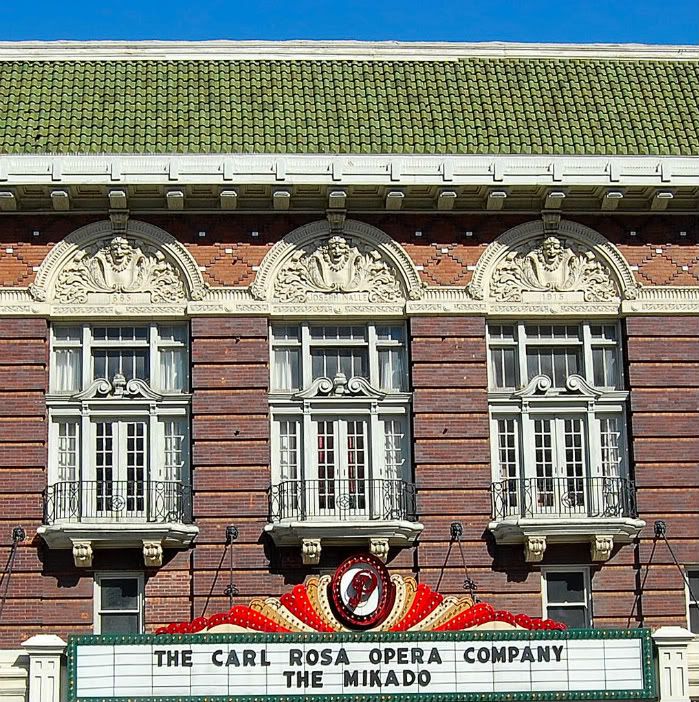
54. Across the street is the Johns-Hamilton Building at 716 Congress Avenue.
photo taken October 20, 2008
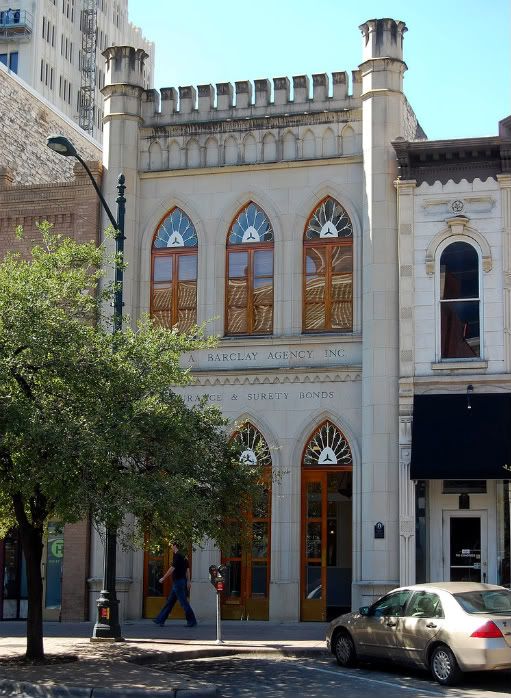
More info on the Johns-Hamilton Building from the Austin Convention and Visitors Bureau:
Originally built during the Reconstruction Era, the facade of the Johns-Hamilton Building is a recent reconstruction of the historic Gothic Revival storefront. Few business houses were built in Austin using this elegant style. In 1870, when the building was completed, C. R. Johns opened a financial institution here.
55. Congress at 8th Street, which was originally named Hickory Street.

The beige three story building on the left is the Eugene Bremond Building. It was built in 1886 and the original owner, Eugene Bremond, came from a prominent merchandising family. The two highrises behind the Bremond Building are Capitol Tower on the right, and Brazos Place on the left. The vacant storefront on the right is 721 Congress which sits next door to the State Theater. When I moved to Austin in 1982, it was a Reynold-Penland Men's store and was later the home of Wild About Music. There are plans to add six stories to the building that would house a ground floor restaurant, second floor office space and condos on the upper five floors.
56. Rendering of proposed project at
721 Congress from Black + Vernooy Architects.
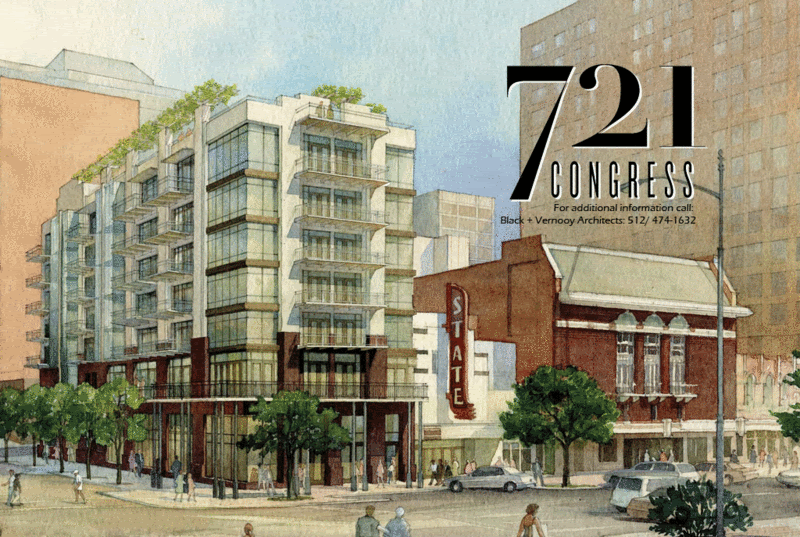
57. Behind 721 Congress, looking towards Brazos Street, the Perry Brooks Building is undergoing renovations. The Perry Brroks Building was completed in 1952 and was the tallest building built in Austin during the 1950's. A portion of the Perry Brooks Building's garage is in what was formerly the Stephen F. Austin Hotel's livery stable. Former tenants have included production offices for "Home Fries" and "Hope Floats," two films that were shot in Austin.
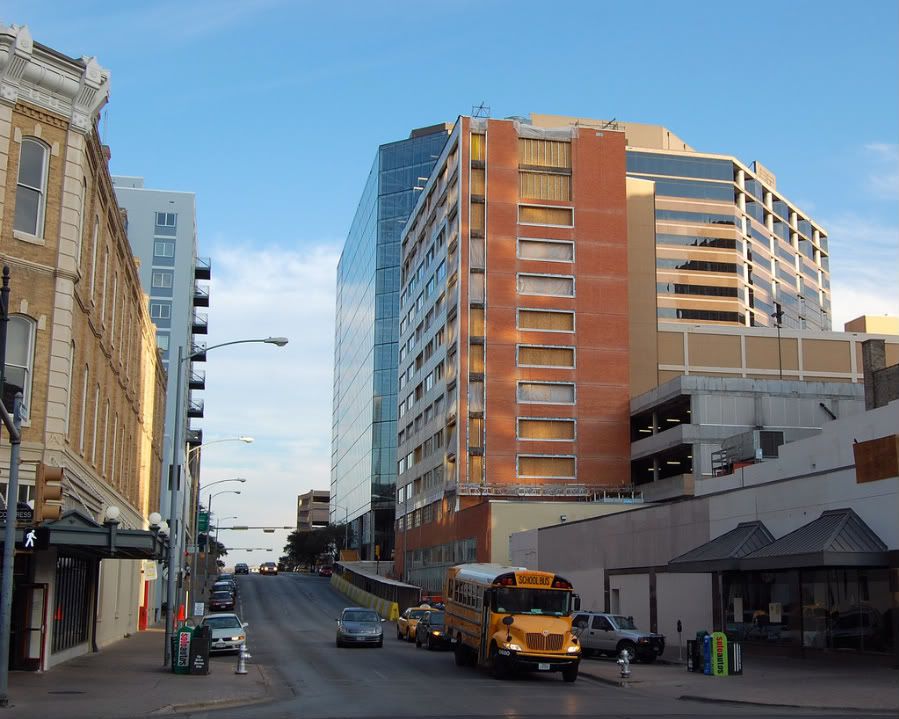
58. Northwest corner of Congress at 8th Street.
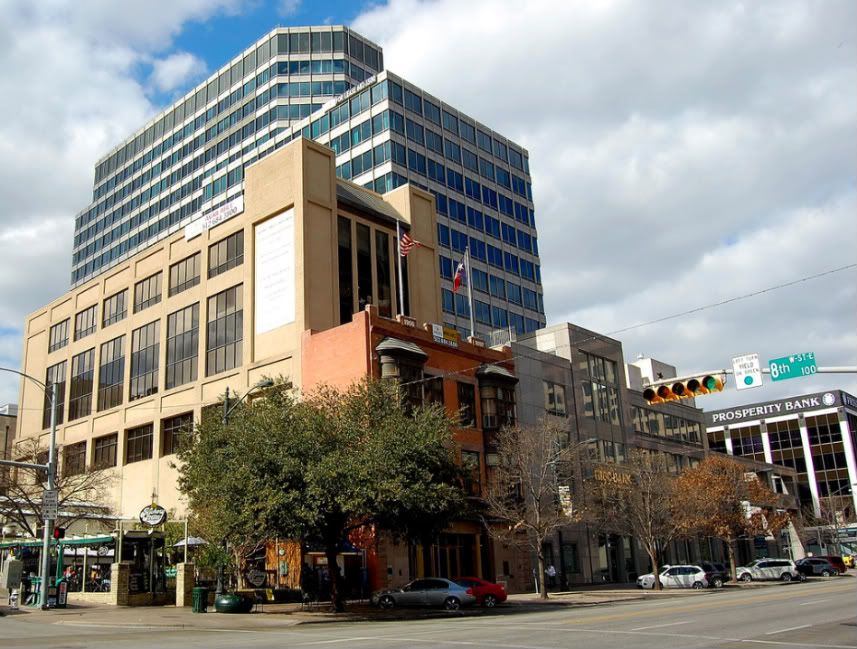
The outdoor seating area to the far left is the Hickory Street Bar and Grill. The highrise is 816 Congress. The small red building on the corner is the Bosche Building, built in 1897.
More info on the Bosche Building from the Austin Convention and Visitors Bureau:
Perhaps the most striking feature of this unusual building is its Queen Anne architecture with faux copper bay windows. The third floor and south half of the building were added in 1906. John McDonald, former mayor of Austin, was the contractor for the original construction. Bosche ran the first steam-operated laundry west of the Mississippi here.
59. Outdoor plaza at 816 Congress.
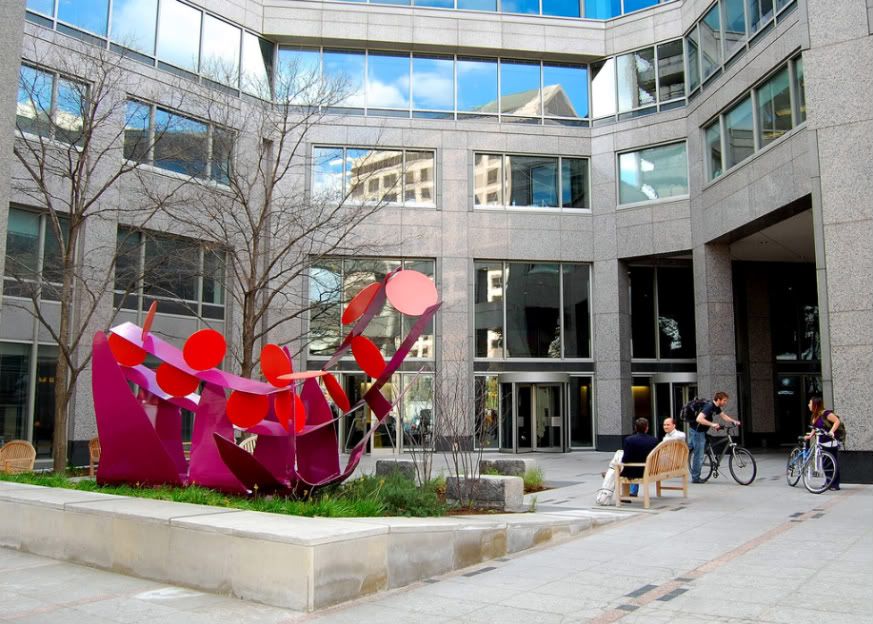
60. Across the street, the Austin Museum of Art is on the ground floor of 823 Congress.
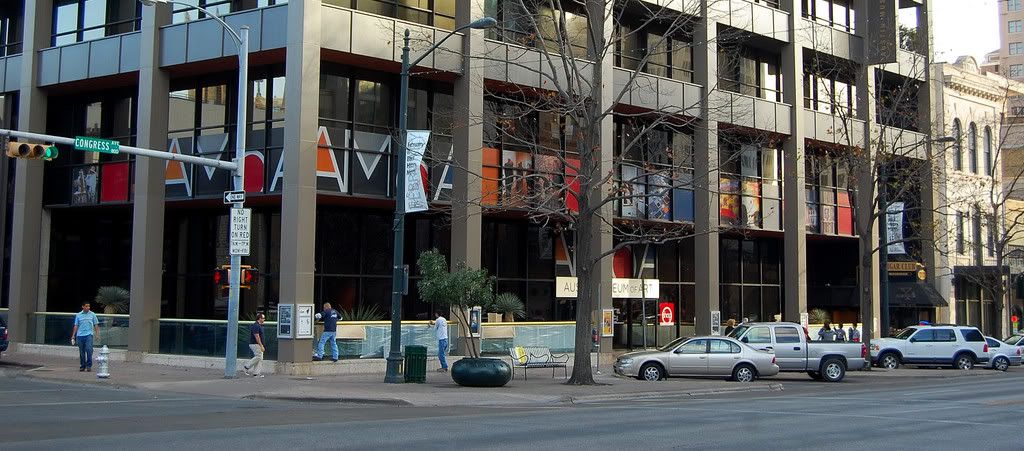
61. Looking south down Congress Avenue from 9th Street which was originally named Ash Street.
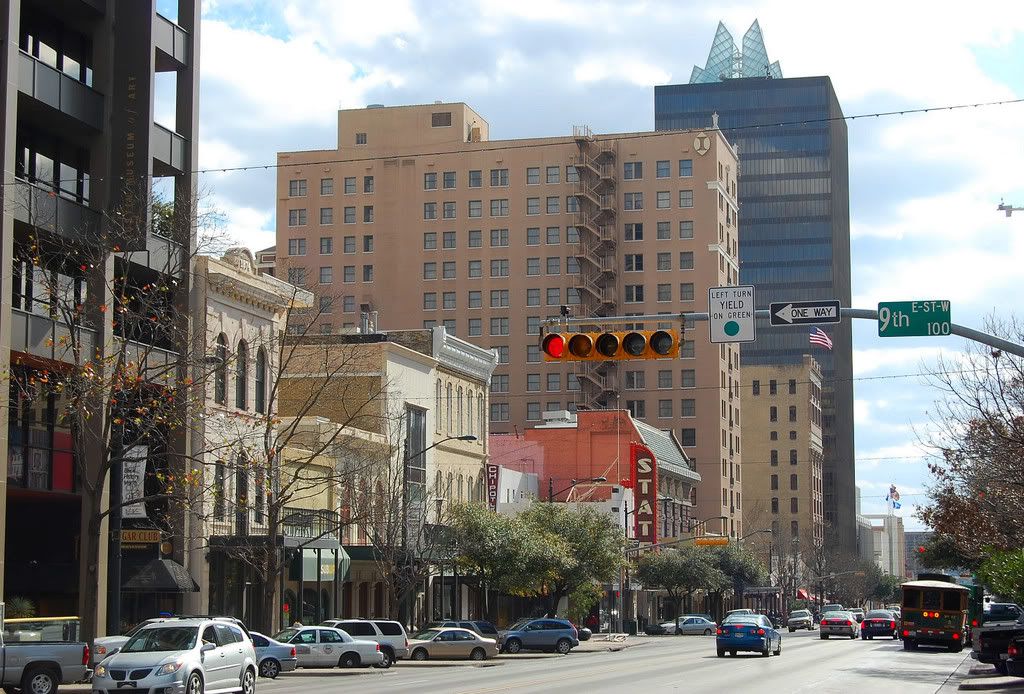
The small three story building between 823 Congress and the Subway Sandwich Shop is the Allen-Von Boeckmann Building, (811 Congress Avenue) built in 1874. Eugene Von Boeckmann owned a publishing company and it's offices were in the building. On the ground floor was the
Bismark Saloon, a favorite haunt of O. Henry, an Austin writer.
The building has been converted into a 8,325 square foot
private residence with four bedrooms, eight baths, a balcony overlooking Congress Avenue, an elevator, a three-car garage and a roof-top pool. The
property listing has several photos of the interior. The asking price is $7.5 million.
An
article from the Texas Society of Architects about the renovation of the building with photos and floorplans.
62. Jacob Lamour Block (1876) 906 - 920 Congress Avenue
photo taken November 27, 2007 from the roof of 1005 Congress.
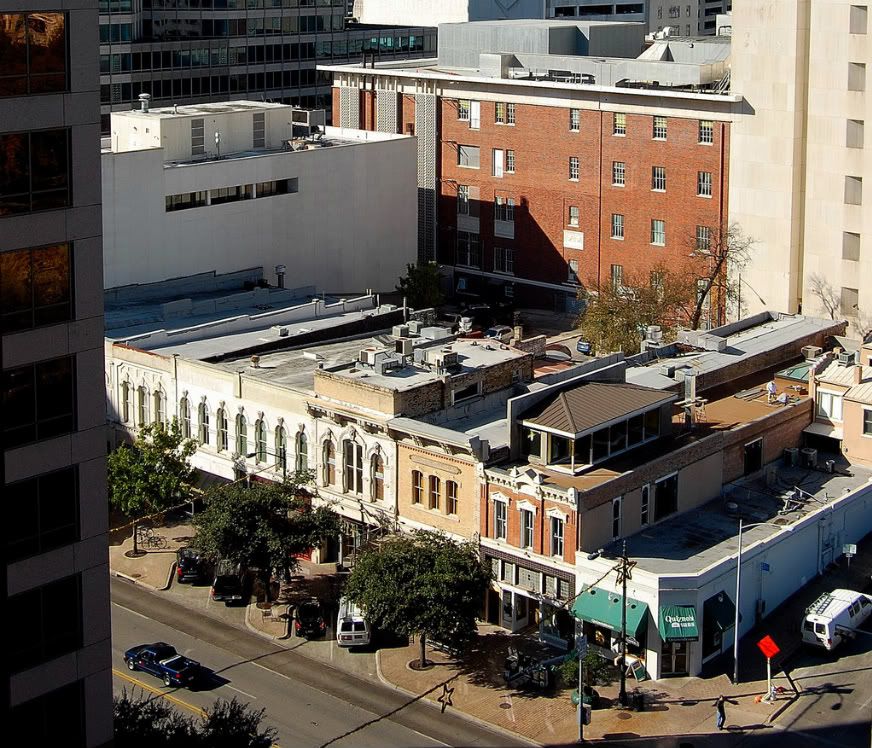
More info on the Jacob Lamour Block from the Austin Convention and Visitors Bureau:
This unique enclave of structures embodies the distinctive Italiante style. The buildings were designed by Jacob Lamour, a native of Hackensack, New Jersey. Lamour originally practiced architecture in New York, came to Austin in 1870 and left numerous monuments of his architectural skill. Lamour was also responsible for the design of courthouses throughout Texas.
63. Outdoor patio at Congress Avenue at 10th Street which was originally named Mulberry Street. The patio is adjacent to the Old Bakery and Emporium.
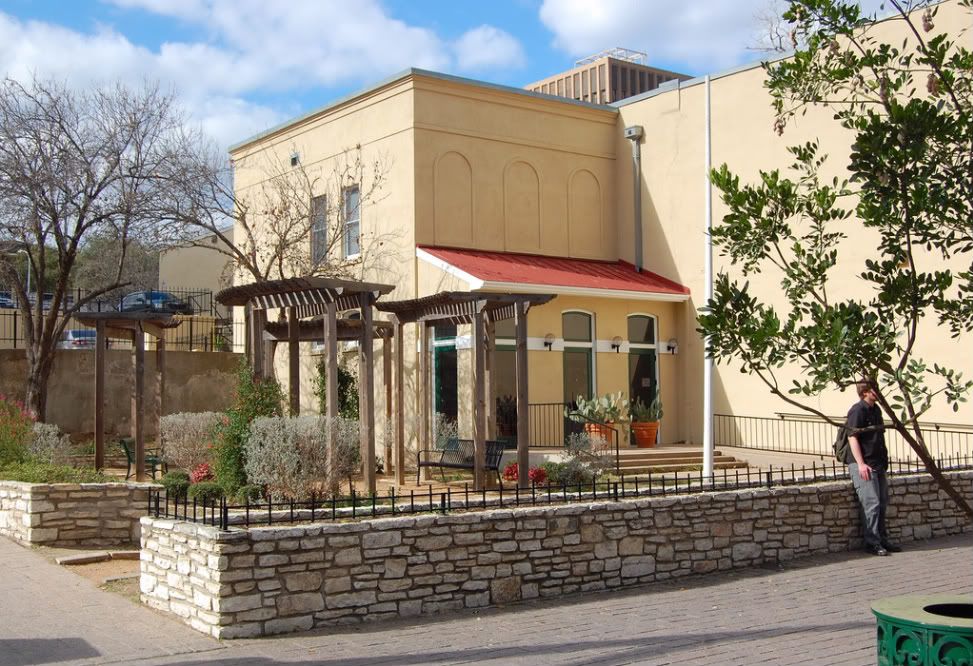
64. Old Bakery and Emporium (1876)
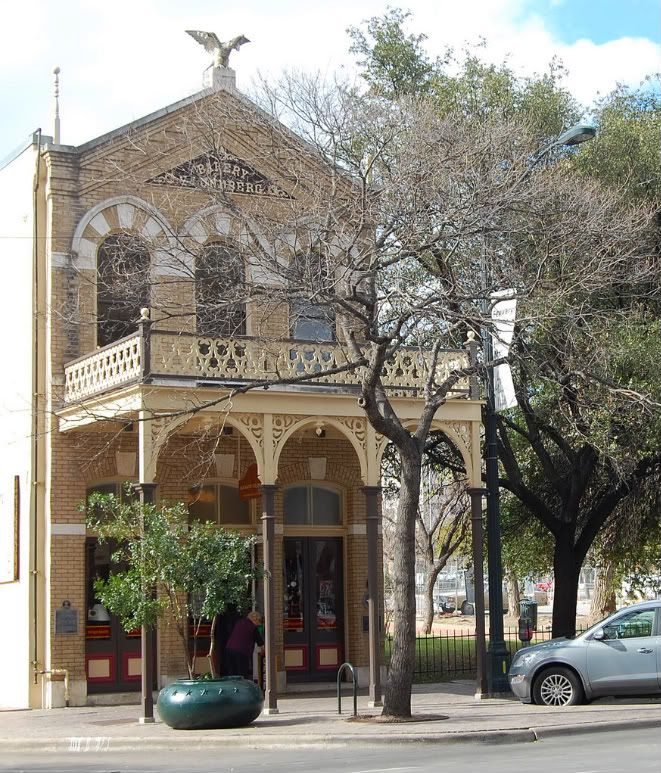
This structure was originally built for Charles Lundberg, a Swedish immigrant who opened a bakery here. It was made of limestone with a brick facade. An eagle, with wings spread, perched atop the gabled roof. The building has undergone a few changes over the years. It originally consisted of two parts, a front store section and a back warehouse, with a chicken coop in the yard between them. Eventually the two sections were joined together. The store front featured an iron canopy, which covered the sidewalk. At some point this overhang had been removed and replaced with a wrought iron balcony. Renovations later restored the canopy.
Lundberg died in 1895, but the building remained a bakery until 1936. For the next 25 years ownership of the building changed hands several times and was used for a variety of purposes, including a nightclub. By 1963 it was vacant, deteriorating and scheduled for demolition. It was saved by the Austin Heritage Society, which purchased the building, and the Junior League of Austin, which donated $12,500 for restoration work. By 1964, the Heritage Society was operating the site as a Tourist Information Center and Coffee Kitchen.
65. Old Bakery and Emporium
photo taken October 20, 2008 (back when things were still green here)
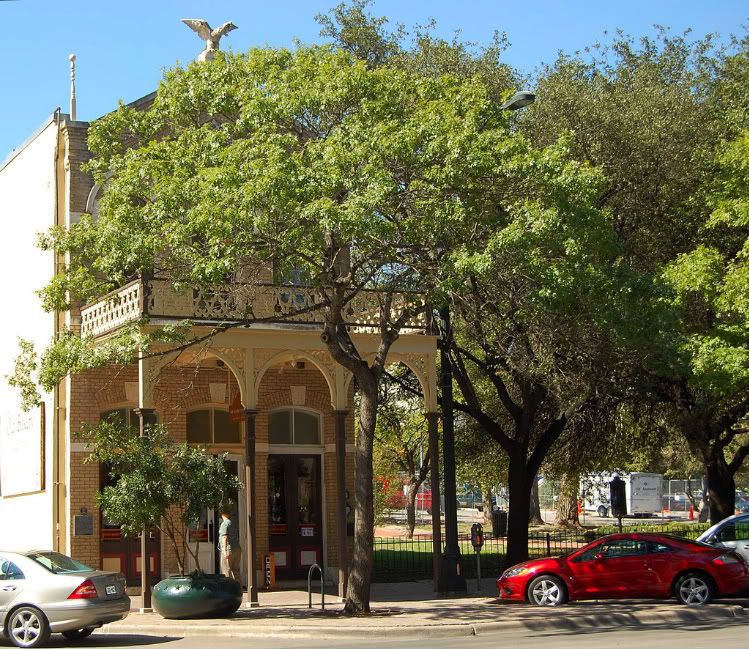
In 1970, the State of Texas purchased the block intending to build a new Highway Department headquarters building. Fortunately, the removal of other buildings on the block uncovered stone ruins of the temporary State Capitol which was used while the present-day Capitol was being built. (The temporary capitol burned to the ground in 1899.) As a result of discovering the ruins, the state saved the property north of the bakery as a park and the Highway Department plan was shelved. The State deeded the property to the City of Austin in 1980. The park is to the right of the Old Bakery & Emporium in the above photo.
66. Crossing 11th Street, which was originally named Mesquite Street, we come to the Texas State Capitol. Looking south down Congress Avenue from the Capitol gates.
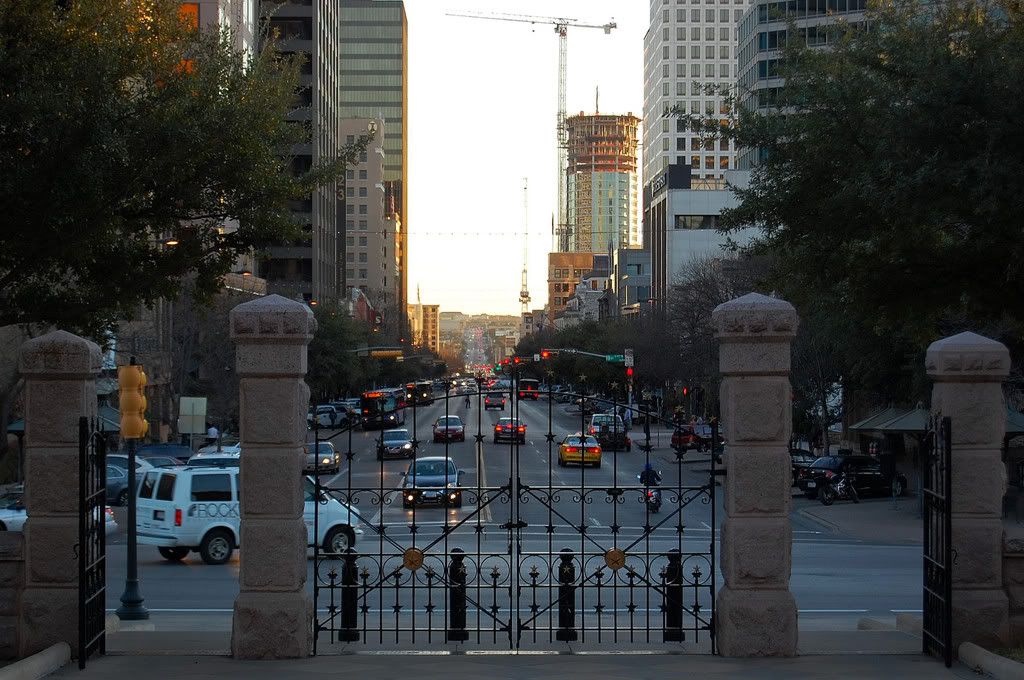
67. On the east side of Congress Avenue, across the street from the Old Bakery and Emporium is 1005 Congress, the brown office building with the horizontal windows. A block south of it - across from the Jacob Lamour block is Capitol Center - the building with the peaked roof. 823 Congress, the Stephen F. Austin Intercontinental Hotel, Bank of America Tower and Frost Tower are also visible.
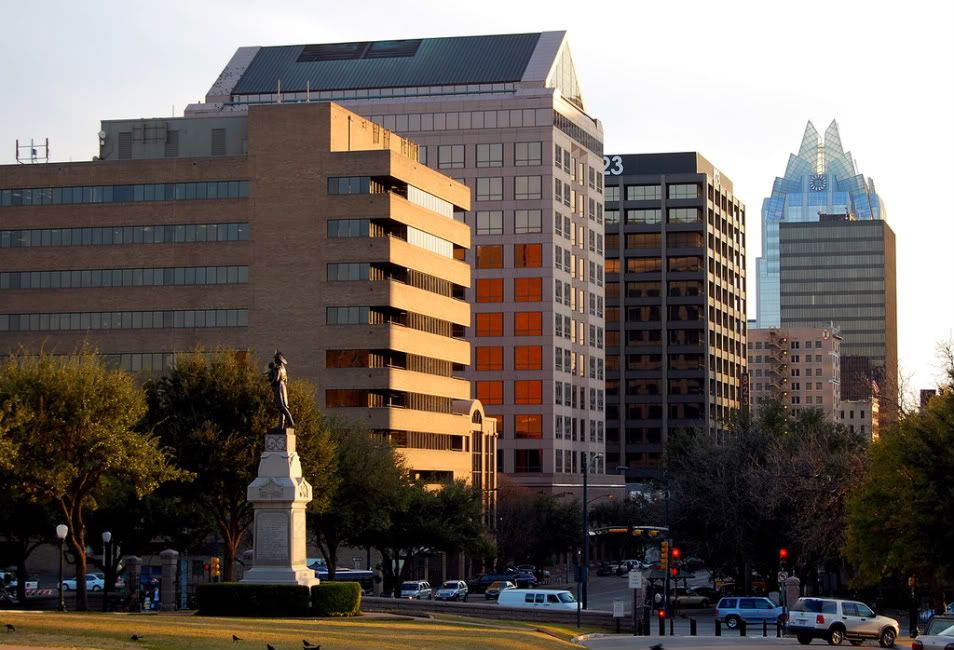
68. Buildings on the west side of Congress including Austonian & Ashton, Scarbrough Building (barely visible with the flags on top in front of the Austonian), One American Center and 816 Congress.
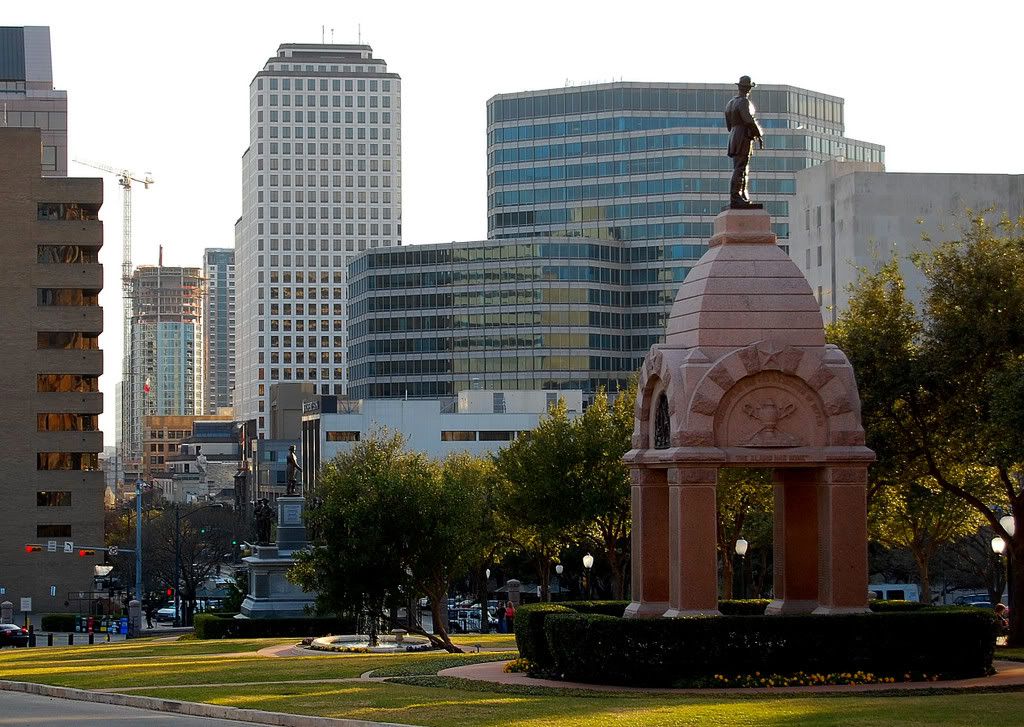
69. Ernest O. Thompson State Office Building
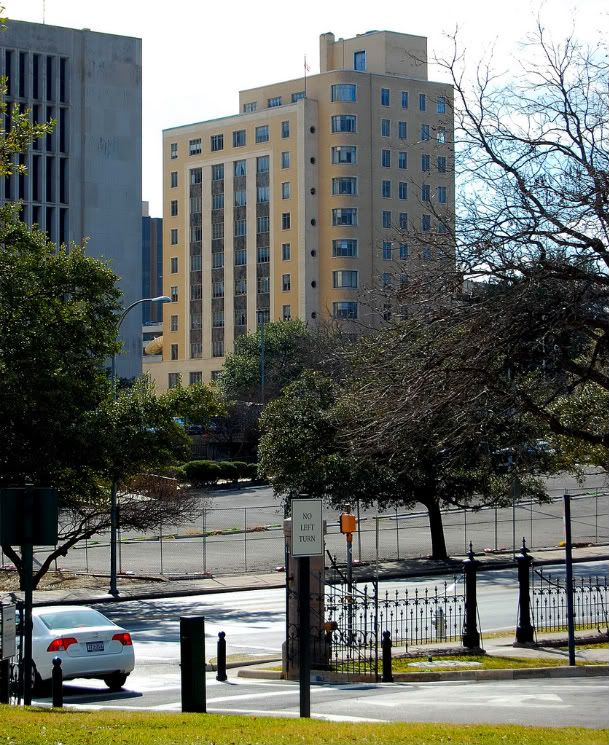
This building was built in 1941 and started its life as the Austin Daily Tribune Building. James Marion West, said to be the richest man in Texas in the 1930's, and one who had political aspirations, was the paper's publisher. The bottom three floors housed the newspapers presses and offices, floors 4-9 were leased out as office space, there was a radio station on the 10th floor and an 11th floor penthouse. The paper debuted on May 25, 1941. In August of 1941, West and his son Wesley were on a business trip to Kansas City, when West caught a cold. He entered a hospital on a Thursday and died three days later. The paper only lasted another 16 months after his death with the last edition being printed December 29, 1942.
In 1945, the state bought the building from West's heirs and in 1965, it was renamed for Ernest O. Thompson, who served on the Texas Railroad Commission for 22 years and retired in 1965.
The Austin American Statesman had a
good article on the history of the building and James West back in December.
70. Texas Trial Lawyers Association Building just west of the Capitol was built in 2000.
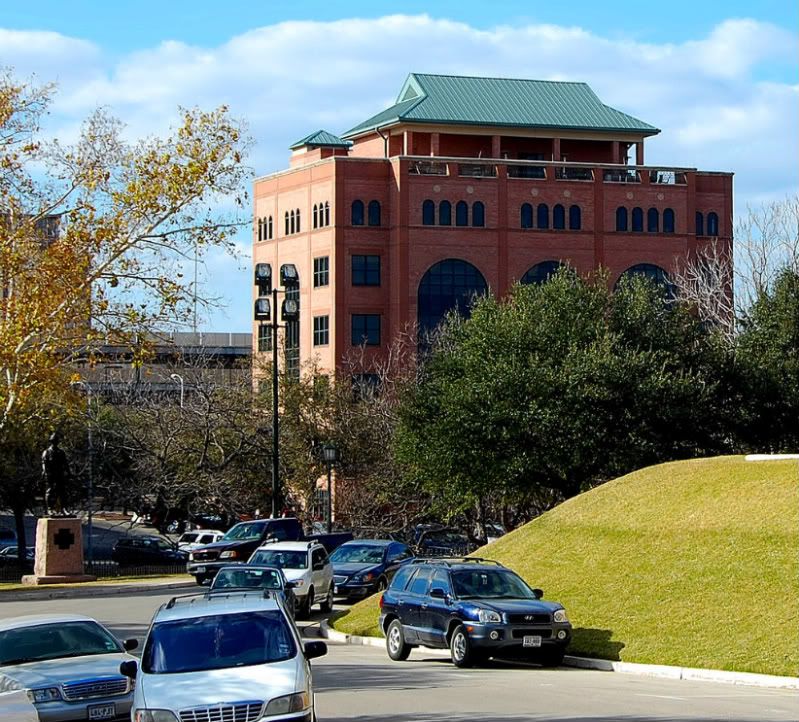
71. The Old General Land Office Building, just east of the Capitol, was built in 1857. Along with the Governor's Mansion (which recently caught fire) the General Land Office is one of the two oldest buildings in the Capitol Complex. It once housed the state of Texas' deeds, patents, maps and other records. Today it serves as the Capitol Visitor Center and gift shop.

72. Capitol Grounds with Congress Avenue in the distance.
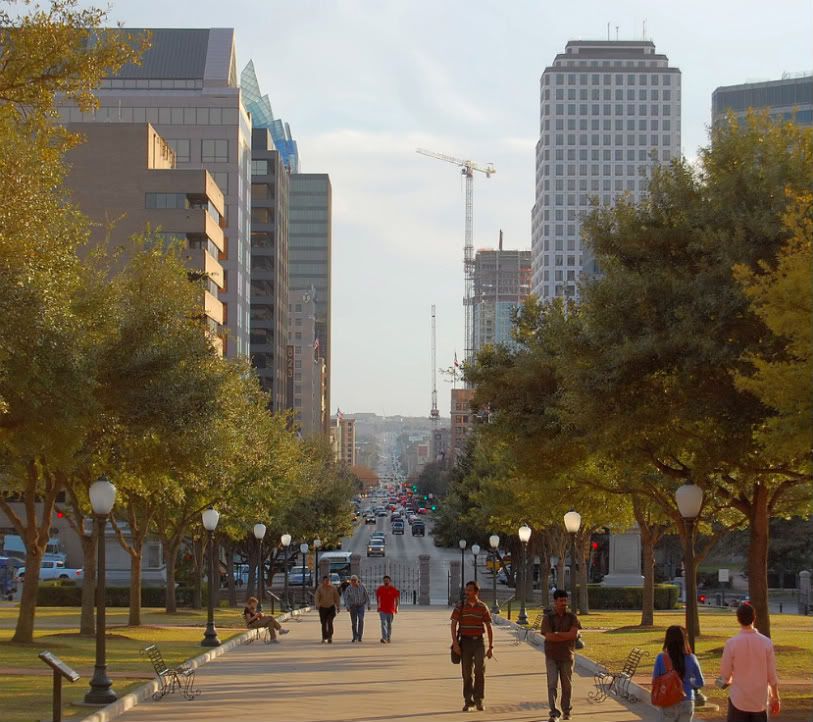
We'll go inside the Capitol for a quick look around.
73. Everything's bigger in Texas, including our door hinges and our egos.

74. Our state legislators hard at work in the House Chambers,
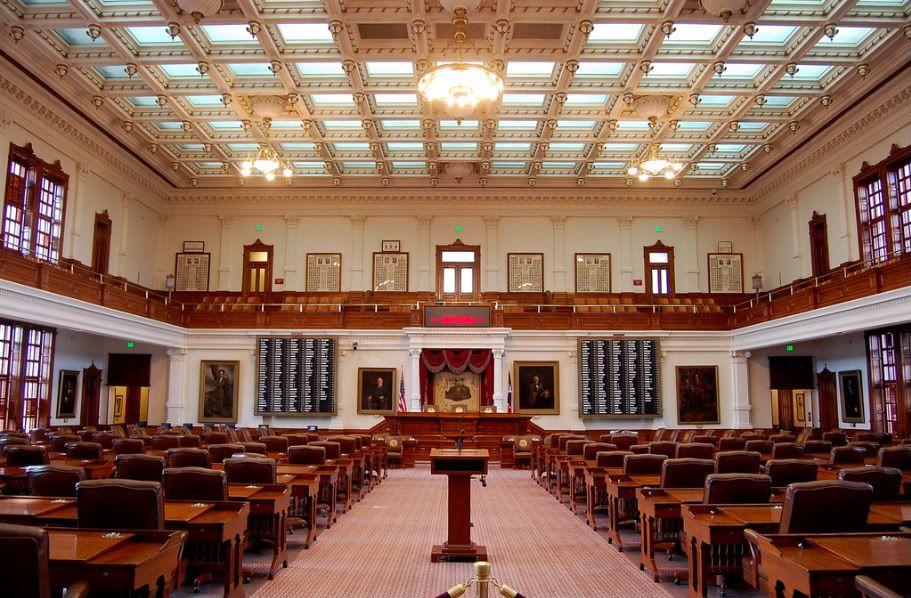
75. And the Senate Chambers.

Oh well. We didn't come to see those fools anyway. See that spectators gallery up above? It's a great place to get some shots of the skyline, and they don't care if you open the shutters, so let's go.
76. Capitol grounds and Congress Avenue
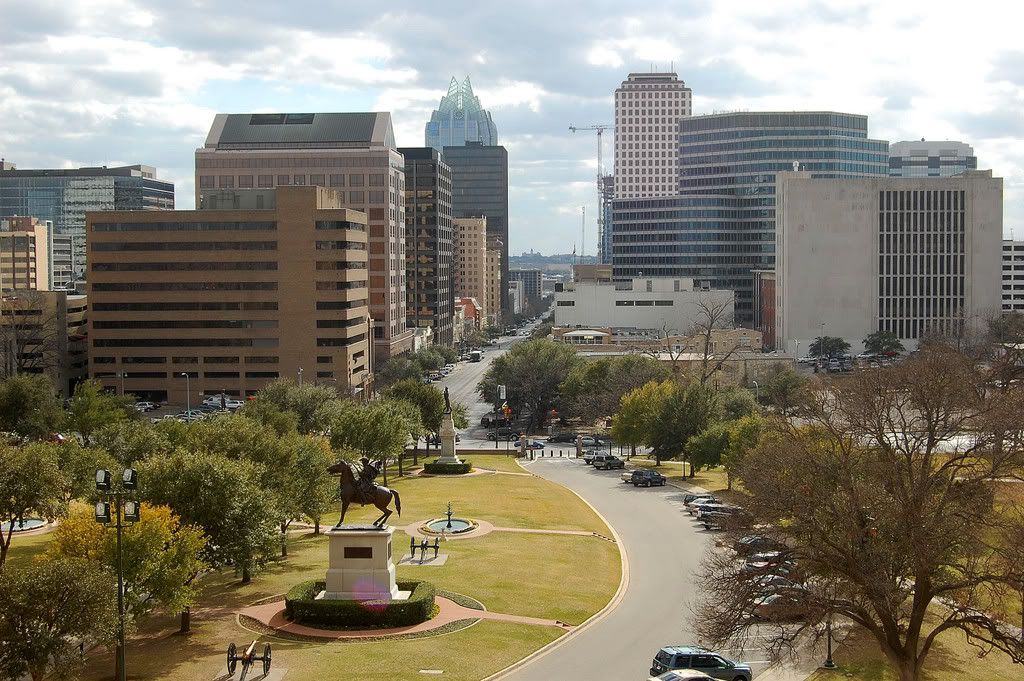
77. Congress Avenue and west side of downtown. Monarch & Spring are on the far right.
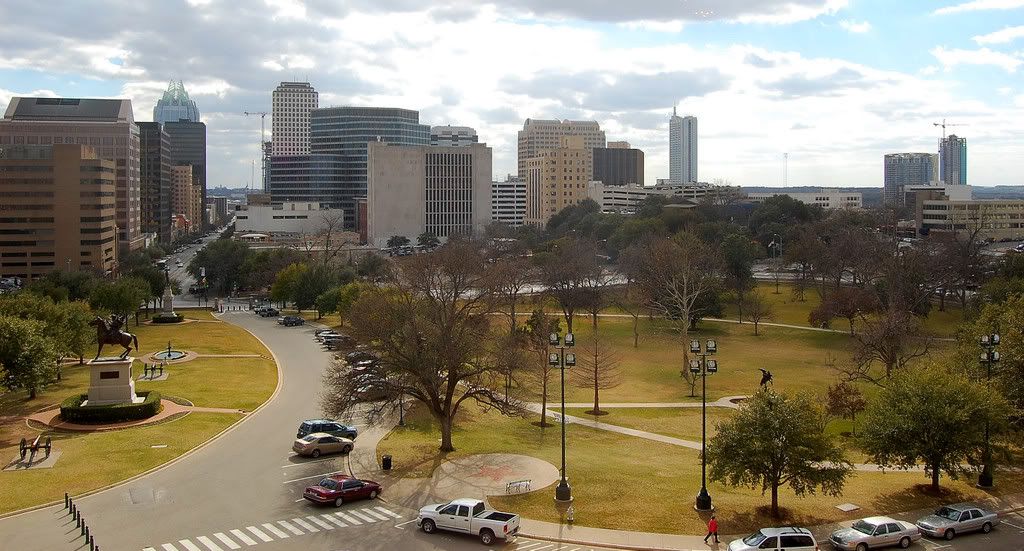
78. Congress Avenue and the east side of downtown.
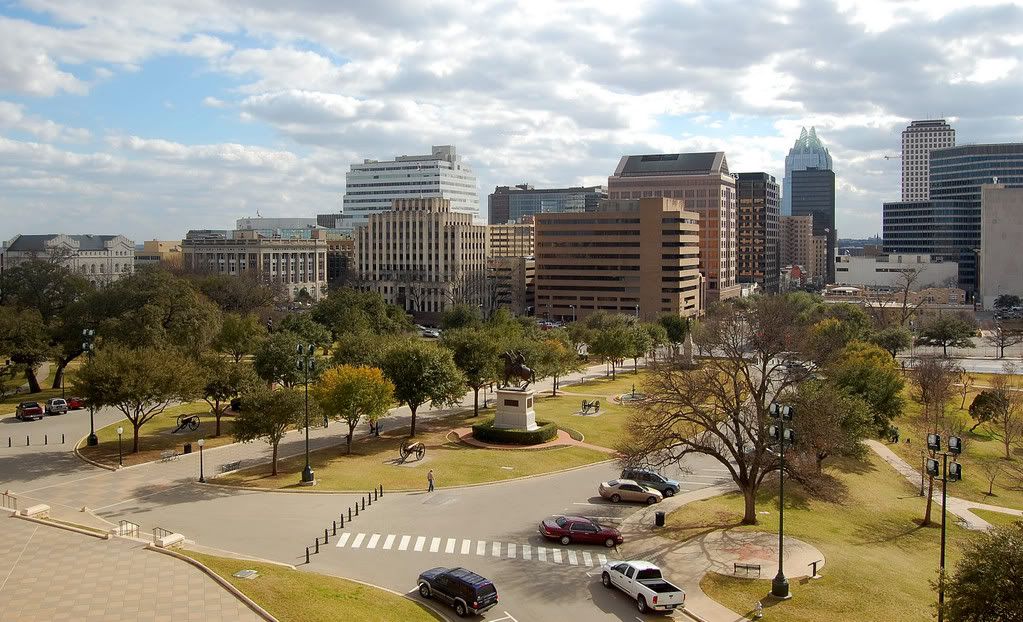
79. Closer view of east downtown buildings. The James E. Rudder State Office Building (1917) is the older building on the left. The Dewitt C. Greer State Office Building (1933) is to the right. The tall highrise behind the Dewitt C. Greer Building is Capitol Tower.
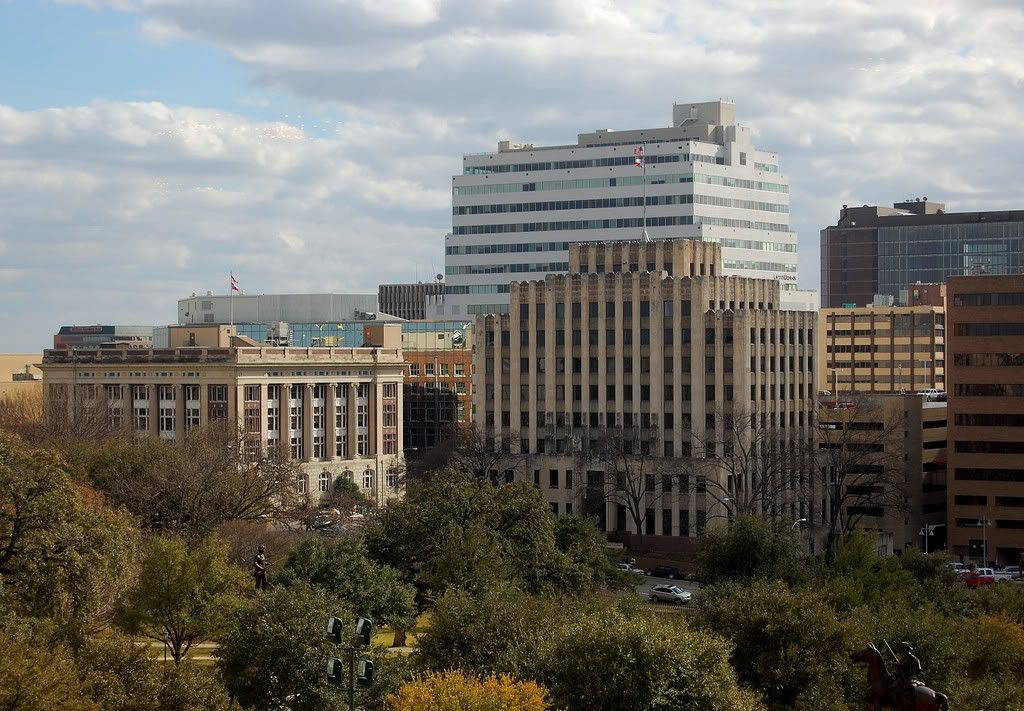
80. Congress Avenue
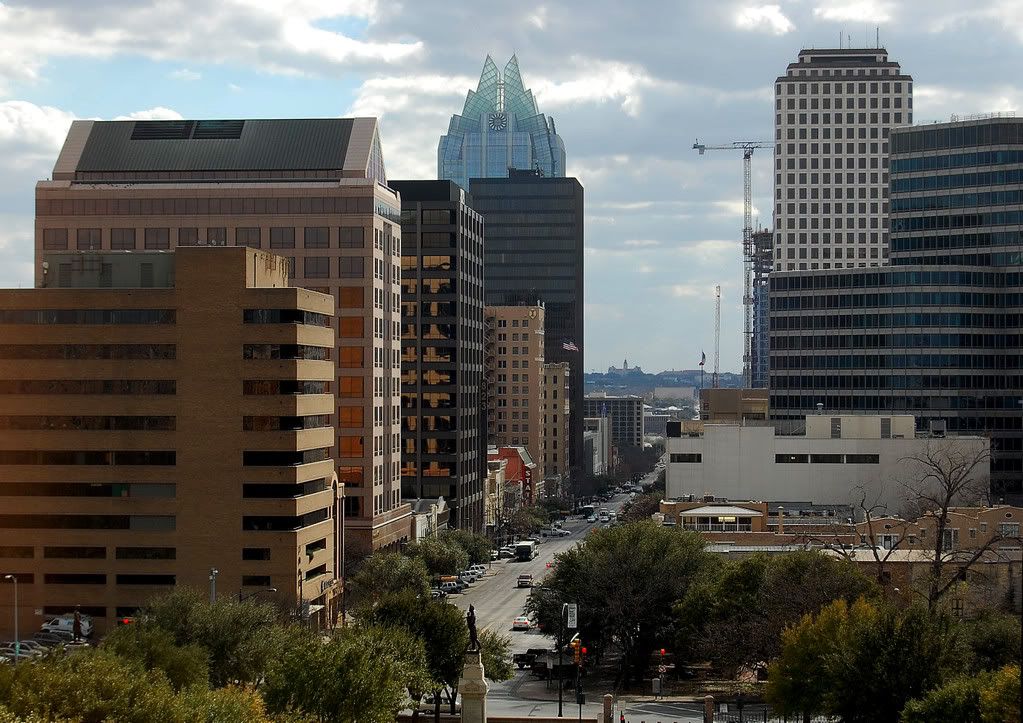
81. Going back downstairs now.
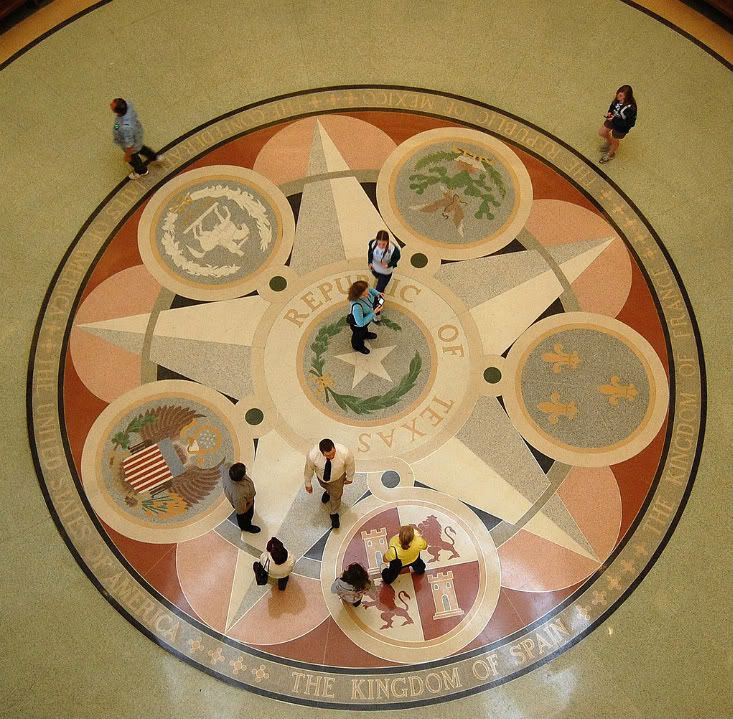
82. Texas State Capitol
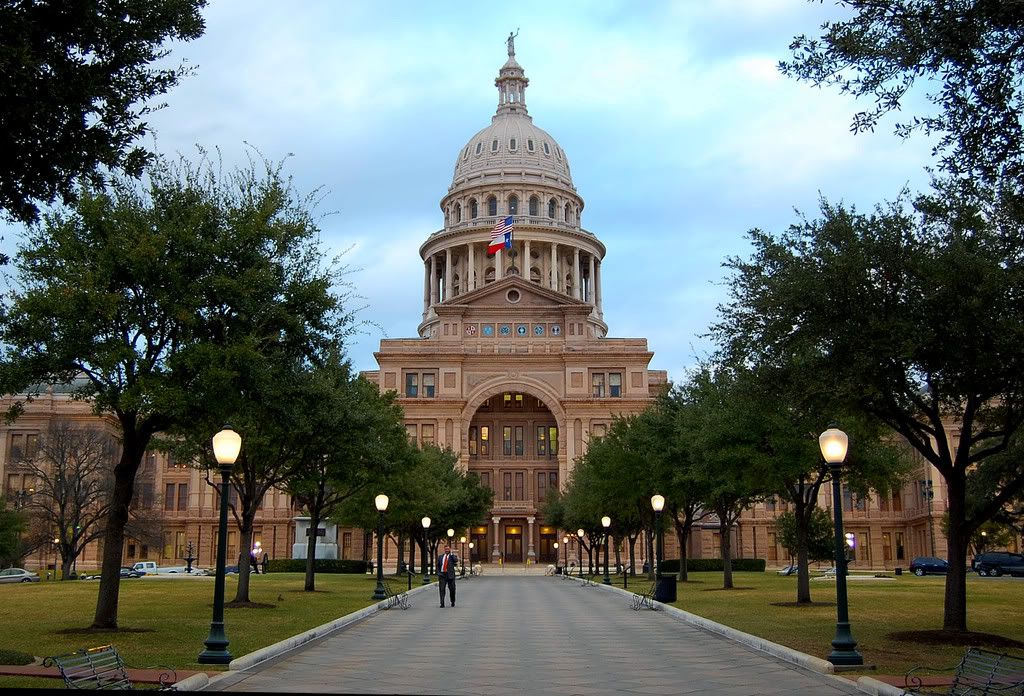
83. Congress Avenue. Time to head home.
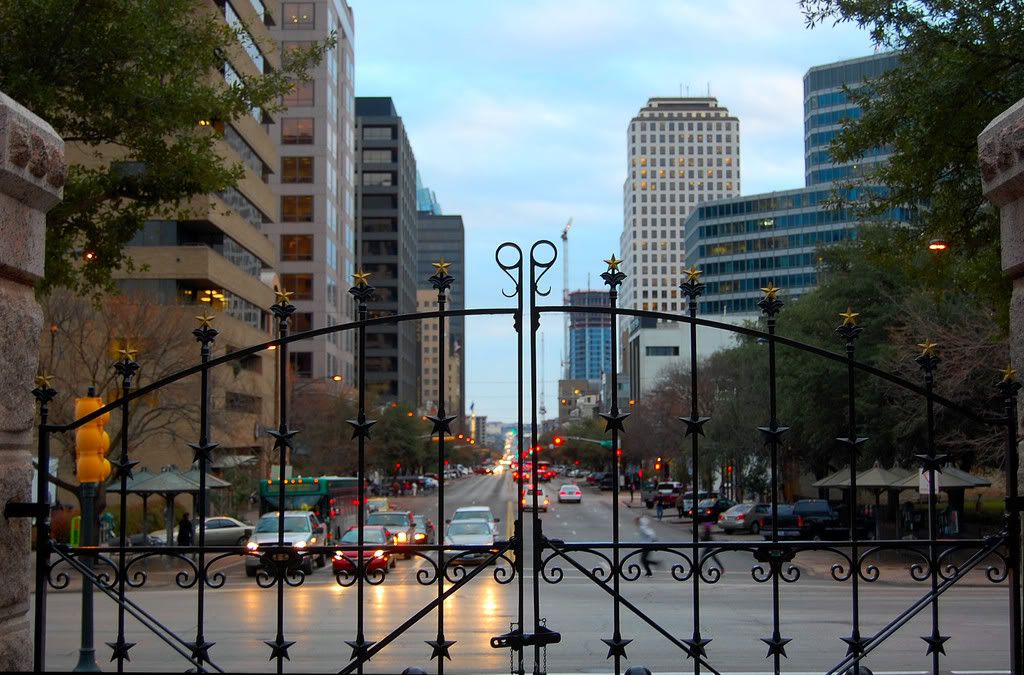
Thanks for looking.